俯冲与折返是俯冲带中最为关键的两个动力学过程,它们控制着板块内部的耦合和拆离(如Hyndman et al., 1997; Conrad et al., 2004; Heuret and Lellemand, 2005; Zhao et al., 2011)、高原的形成与垮塌(如Pfiffner et al., 2000; O’Brien, 2001; Chen et al., 2006, 2008) 以及高压-超高压(HP-UHP) 岩石的形成和抬升(如Ernst et al., 1997; Chopin, 2003; Carswell and Compagnoni, 2003; Lapen et al., 2007)。到目前为止,俯冲带的研究内容其实大部分与板块俯冲过程相关,包括板块俯冲的最大深度(Irifune et al., 1994; Dobrzhinetskaya and Green, 2007; Wu et al., 2009)、俯冲的速率和地温梯度(Kirby, 2000; Lapen et al., 2003; Syracuse et al., 2010)、俯冲过程中的矿物相变和HP-UHP变质(Ye et al., 2000; Nishiyama et al., 2005; Chen et al., 2013a)、俯冲带熔流体活动和元素循环(Scambelluri and Philipot, 2001; Guo et al., 2012; Chen et al., 2013b)、岛弧岩浆作用(Plank and Langmuir 1993; Elliot et al. 1997; Churikova et al. 2001; Manning, 2004) 和板内地震的发生机制(Yuan et al., 2000; Omori et al., 2004; Rondenay et al., 2008) 等。而近十几年来,越来越多的学者开始致力于板块折返机制的研究,其中俯冲陆壳的折返机制已基本达成共识。陆壳以长英质成分为主,密度较低,即使俯冲到200km的深度其密度仍小于周围地幔,可由于浮力作用而自行折返到地壳深度(Davies and von Blanckenburg, 1995; Ernst et al., 1997; Ernst, 2001, 2005, 2006; Lapen et al., 2007; Wu et al., 2009),从而在大陆俯冲碰撞造山带中出露大量的HP-UHP陆壳岩石。
洋壳在俯冲过程中经历HP-UHP变质而转变为蓝片岩和榴辉岩。以往的研究者普遍认为,俯冲洋壳以大洋中脊玄武岩(MORB) 成分为主,密度较大,转变为榴辉岩后其密度大于周围地幔,从而可俯冲到过渡地幔(Zhao et al., 2007; Zhao, 2008),下地幔(Litasov and Ohtani, 2005; Perrillat et al., 2006),甚至核幔边界(Hirose et al., 2005),很难由自身浮力而折返回地表。但是,在现今大洋俯冲带中出露了一些洋壳榴辉岩(如Agard et al., 2009; Wei et al., 2009a; Zhai et al., 2011; Brovarone et al., 2011; Plunder et al., 2012),甚至有些洋壳榴辉岩含有柯石英,说明它们俯冲到90km以下的深部地幔并经历了UHP变质作用(Lü et al., 2009; Groppo et al., 2009; Angiboust et al., 2012)。HP-UHP洋壳榴辉岩的出露表明至少有一部分洋壳与俯冲大洋板块拆离并折返回地表,但这部分洋壳是由于什么机制而折返仍不明确,并且存在很大争议(Gerya et al., 2002; Gorczyk et al., 2007; Krebs et al., 2008; Blanco-Quintero et al., 2010; Malatesta et al., 2012)。
近三十年来,众多研究学者提出了多种俯冲洋壳的折返模式,其中包括:(1) 增生楔中低密度变沉积岩携带榴辉岩折返(Shreve and Cloos, 1986; Platt, 1986);(2) 低密度陆壳物质携带洋壳榴辉岩折返(Ernst, 2001; Chopin, 2003;Plunder et al., 2012);(3) 低密度蛇纹岩俯冲通道携带洋壳榴辉岩折返(Hermann et al., 2000; Guillot et al., 2001, 2009; Angiboust and Agard, 2010)。这些模式的提出都基于一个假设前提:洋壳榴辉岩比周围地幔重,因此它的折返必须借助于其他低密度岩石。是不是洋壳榴辉岩一定比地幔密度大呢?我们总结发现,现今折返的洋壳榴辉岩都为低温含水榴辉岩,温度普遍小于650℃,压力低于3.2GPa,并且在典型的大洋俯冲带中还未发现高温榴辉岩(如Groppo et al., 2009; Lü et al., 2009; Wei et al., 2009a; Angiboust and Agard, 2010; Zhai et al., 2011; Angiboust et al., 2012; Brovarone et al., 2011; Plunder et al., 2012)。大量的实验研究表明,俯冲洋壳(MORB) 在高温高压条件下(可至核幔边界压力条件) 的密度远远大于周围地幔(如Aoki and Takahashi, 2004; Litasov and Ohtani, 2005)。然而,为了使矿物相在实验条件下达到平衡并减少实验持续时间,这些高温高压实验的设定温度普遍很高,一般大于900℃,高于MORB的固相线,从而实验获得的产物为干的高温榴辉岩,以这些高温榴辉岩计算的密度显然无法代表俯冲洋壳的低温含水榴辉岩的密度。尽管少数MORB体系的实验温度降低到了550℃(Poli, 1993; Schimdt and Poli, 1998; Forneris and Holloway, 2003),但是这些实验并没有对低温榴辉岩的密度进行标定,因而低温榴辉岩的密度演化仍不明确。本文通过总结大洋俯冲带中折返到地表的洋壳榴辉岩的岩石学特征、变质作用和演化历史,结合笔者近期的热力学模拟结果,对俯冲洋壳的折返机制以及相关争议性问题阐述初步看法。
2 洋壳榴辉岩的基本特征本文从已有文献中搜集了典型大洋俯冲带中出露地表的洋壳榴辉岩基础资料,目前已知出露的洋壳榴辉岩的全球分布详见图 1,峰期矿物组合、温压条件、全岩成分、折返的P-T轨迹以及数据来源详见表 1。
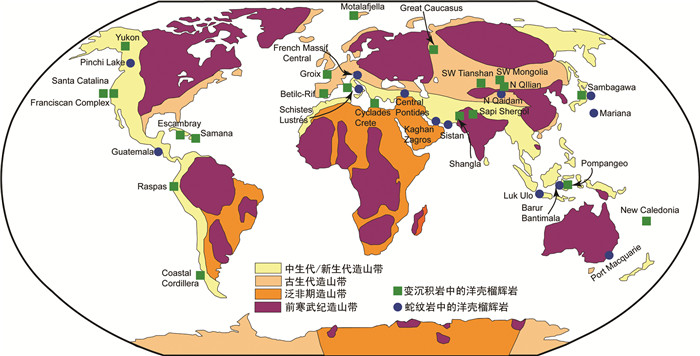
|
图 1 全球洋壳榴辉岩分布图(据Guillot et al., 2009修改) Fig. 1 Distribution of oceanic eclogites in the world (modified after Guillot et al., 2009) |
|
|
表 1 全球折返到地表的洋壳榴辉岩基础资料 Table 1 Comparison of availiable data on exhumed oceanic eclogites worldwide |
目前全球范围内所发现的典型洋壳榴辉岩地点有30多处,大部分都位于古生代-中/新生代造山带中,只有极少数位于泛非期和前寒武纪造山带,如澳大利亚的Port Macquarie硬柱石榴辉岩(图 1)。在我国,洋壳榴辉岩仅见于西南天山、北祁连和柴北缘沙柳河(图 1)。柴北缘沙柳河榴辉岩(Zhang et al., 2008) 和French Massif Central中的Limousin榴辉岩(Berger et al., 2010) 出露于典型的大陆俯冲碰撞造山带,其它洋壳榴辉岩都位于典型的大洋俯冲带,本文主要针对典型的大洋俯冲带中的榴辉岩展开讨论。
众所周知,俯冲洋壳包括基性洋壳和沉积盖层。现今大洋俯冲带出露的HP-UHP岩石包括变沉积岩、蛇纹岩(或蛇纹石化的橄榄岩)、基性蓝片岩和榴辉岩。洋壳榴辉岩在野外一般呈透镜体状产于变沉积岩或者蛇纹岩中,透镜体大小不一,可从厘米级到千米级不等,部分洋壳榴辉岩仍保存了完好的枕装结构(Gao and Klemd, 2003; Zhang et al., 2008)。变沉积岩的原岩是俯冲基性洋壳之上的沉积盖层,主要由变杂砂岩和变泥质岩组成,一般认为它们在参与俯冲之后都堆集在增生楔(accretionary wedge) 之中(Thurston, 1985; Miyazaki et al., 1996; Wei et al., 2009b; Agard et al., 2009)。典型的大洋俯冲带中出露最多的就是增生楔变沉积岩,如我国的西南天山和北祁连、Franciscan杂岩带和日本Sambagawa造山带等(图 1)。另外,蛇纹岩在大洋俯冲带中亦为常见,出露面积一般少于增生楔变沉积岩,但在少数地区其出露面积可大于变沉积岩,如西阿尔卑斯造山带Monte Raffray地区(Angiboust and Agard, 2010)。大量的研究表明,大洋俯冲带中的蛇纹岩主要来自于俯冲洋壳之上的地幔楔(Guillot et al., 2001, 2009; Scambelluri et al., 2001; Fitzherbert et al., 2004; Hattori and Guillot, 2007),也有少量可能来自于俯冲洋壳之下的富水低温地幔(Chalot-Prat et al., 2003; Li et al., 2004)。
2.2 岩石学特征除典型的榴辉岩相矿物组合石榴石+绿辉石外,折返到地表的洋壳榴辉岩还含有丰富的高压含水矿物,如硬柱石、蓝闪石、绿帘石、多硅白云母、钠云母和硬绿泥石等(表 1、图 2)。其中,蓝闪石/冻蓝闪石、绿帘石和多硅白云母是洋壳榴辉岩中最为普遍的含水矿物。此外,目前已有14个地区报道了硬柱石或者硬柱石假象的存在(表 1)(如Tsujimori et al., 2006a; Agard et al., 2009; Lü et al., 2009; Wei et al., 2009a; Angiboust et al., 2012)。少数地区的富Na富Al的洋壳榴辉岩中还含有钠云母和硬绿泥石(表 1)。与大陆俯冲碰撞造山带中出露的榴辉岩(陆壳榴辉岩) 相比,洋壳榴辉岩具有两个特殊的岩石学特征:
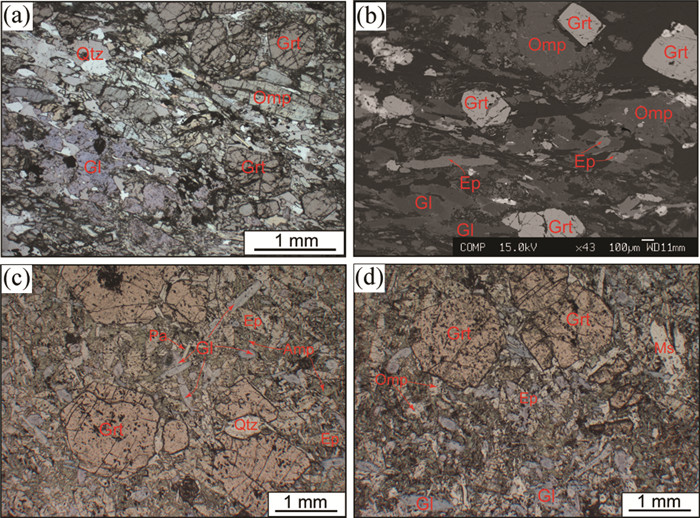
|
图 2 洋壳低温榴辉岩显微照片(a、b)-西阿尔卑斯造山带榴辉岩;(c、d)-南天山榴辉岩 Fig. 2 Photomicrographs (a, c, d) and back scattered electron image (b) showing textures of the low-temperature oceanic eclogites from Western Alps (a, b) and South Tianshan (c, d) |
(1) 低密度含水矿物含量远超陆壳榴辉岩。陆壳榴辉岩典型的矿物组合为石榴石+绿辉石+金红石+多硅白云母+石英/柯石英±蓝晶石(Carswell et al., 1997; Schimd et al., 2001; Rolfo et al., 2004),尽管有部分相对较冷的榴辉岩(如含绿帘石和冻蓝闪石的榴辉岩),但含水矿物总量较低。而洋壳榴辉岩含水矿物的总量一般占岩石的20vol%以上(图 2),最高可达70vol%(如Ghent et al., 2009)。含水矿物的含量一般由岩石体系含水量或者温度控制。岩石中含水量越高,或者岩石变质温度越低,那么形成的含水矿物可能越多(Wei and Clarke, 2011; Chen et al., 2013c)。洋壳的含水量高于陆壳,这是因为冷的洋壳在俯冲之前一般都经历了洋底蚀变作用(Angiboust and Agard, 2010)。而且洋壳榴辉岩的峰期变质温度几乎都低于陆壳榴辉岩(图 3,详见后述)。以上这两种因素应该是导致洋壳榴辉岩中含水矿物高于陆壳榴辉岩的主要原因。除帘石外,绝大部分含水矿物密度都低于地幔值,如蓝闪石(3.14g/cm3)、多硅白云母(2.80g/cm3)、硬柱石(3.13g/cm3)、滑石(2.73g/cm3) 和绿泥石(2.58g/cm3)(Angiboust and Agard, 2010)(图 4)。除石英(2.76g/cm3) 和柯石英(2.92g/cm3) 外,名义上不含水矿物密度都大于周围地幔值,其中石榴石、绿辉石、蓝晶石和金红石是典型的高密度矿物。因此,榴辉岩密度大小取决于低密度含水矿物和高密度矿物的比例。低密度高压含水矿物的含量和稳定性也直接影响着俯冲洋壳的密度,高含量的含水矿物对洋壳榴辉岩的折返可能有重要作用。
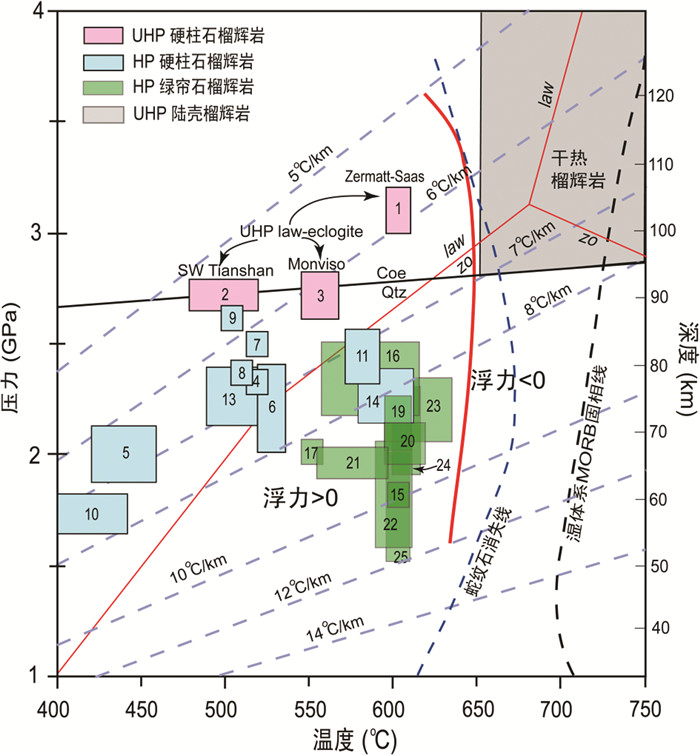
|
图 3 全球25个地区洋壳榴辉岩的峰期温压条件(据Chen et al., 2013c) 图中编号与表 1一致.阴影部分代表大陆俯冲碰撞造山带中的UHP榴辉岩峰期温压条件,硬柱石、黝帘石的稳定域和固相线参照Schmidt and Poli (1998)的实验结果,蛇纹石稳定域参照Padron-Navarta et al.(2010),石英-柯石英转变线由THERMOCALC程序计算.红色的粗线代表洋壳榴辉岩折返的最大深度曲线,曲线的左侧代表洋壳榴辉岩可以依靠自身浮力折返.值得注意的是,自然界出露的洋壳榴辉岩峰期温压条件都位于曲线的左侧 Fig. 3 Plots of the peak metamorphic P-T conditions of the reported natural oceanic eclogites (after Chen et al., 2013c) The numbers in this figure are the same as in Table 1. For comparison, the estimated P-T region of UHP continental eclogites is also shown. The lawsonite and zoisite stability curves and the wet MORB solidus were taken from Schmidt and Poli (1998). The antigorite stability was after Padron-Navarta et al. (2010). The transition of quartz and coesite was calculated using THERMOCALC. The red solid line is depth limit curve for the exhumation of oceanic eclogites calculated on the basis of various geothermal gradients. The left side of the curve represents the P-T region that is suitable for buoyancy-driven exhumation. Note that all of the estimated P-T conditions associated with the worldwide natural oceanic eclogites are located within the left side of the curve |
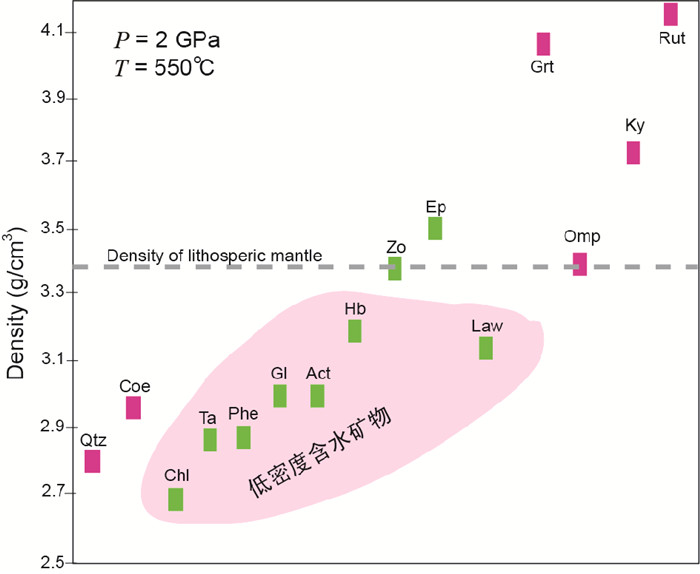
|
图 4 在2GPa和550℃条件下,榴辉岩中常见矿物的密度(据Hacker et al., 2003方法计算) Fig. 4 Calculated common mineral densities in eclogites at 2GPa and 550℃ (based on the calculation method of Hacker et al., 2003) |
(2) 普遍缺少高密度的蓝晶石。蓝晶石是陆壳榴辉岩中较为稳定和常见的高压矿物,它不仅可以跟石榴石和绿辉石平衡共生,而且还能与冻蓝闪石和绿帘石等含水矿物平衡共生,如大别山UHP带花凉亭和港河地区的蓝晶石-绿帘石榴辉岩(Guo et al., 2012, 2013)、苏鲁UHP带东海和荣成地区的蓝晶石榴辉岩(Nakamura and Banno, 1997; Zhang et al., 2000) 等。然而在典型的大洋俯冲带中,已折返到地表的洋壳榴辉岩普遍缺少蓝晶石,甚至在某些富Al的含硬绿泥石榴辉岩中亦未发现蓝晶石(Spandler et al., 2011; Angiboust et al., 2012)。蓝晶石的普遍缺失是否意味着含蓝晶石的榴辉岩难以折返?解开这一谜团,必须明确含蓝晶石榴辉岩稳定的温压范围和密度。
2.3 温压条件图 3和表 1总结了折返洋壳榴辉岩的峰期温压条件,不难看出,所有洋壳榴辉岩的峰期压力都低于3.2GPa (如Zhang et al., 2008; Agard et al., 2009; Guillot et al., 2009),绝大多数的峰期压力在1.5~2.5GPa之间,只有极少数洋壳榴辉岩达到了UHP条件。此外,与这些洋壳榴辉岩伴生的蛇纹石化地幔橄榄岩都属于尖晶石相( < 80km, 如Guillot et al., 2001)。这些都说明洋壳榴辉岩和蛇纹岩化橄榄岩的折返深度不超过110km。而在大陆俯冲碰撞造山带中,却出露大量的UHP变质岩,其中部分变质岩记录了>200km的超深俯冲信息(Ye et al., 2000; Song et al., 2004; 刘良等,2005;Liu et al., 2007)。另一方面,洋壳榴辉岩的峰期温度普遍低于650℃(图 3、表 1),大部分峰期温度在550~600℃之间,为低温榴辉岩。多米尼加共和国Samana地区的硬柱石榴辉岩是目前全球记录最低温度的榴辉岩(~360℃)(Zack et al., 2004),但是这种低温可能是由于石榴石-单斜辉石温度计的巨大误差造成的(Wei and Clarke, 2011)。这里必须注意到,洋壳榴辉岩低温并不是说明只有冷俯冲带的榴辉岩才能折返。在一些典型的经历热俯冲的大洋俯冲带,如日本Sambagawa造山带(Wallis et al., 2000; Tsujimori and Matsumoto, 2006; Kabir and Takasu, 2010),出露的榴辉岩峰期温度也不超过650℃(表 1)。较低的温度更有利于含水矿物的稳定,这可能是洋壳榴辉岩中含水矿物多的原因之一。尽管陆壳榴辉岩中有一部分也含有蓝闪石/冻蓝闪石和绿帘石等低温高压含水矿物,但是它们的峰期温度普遍高于650℃(如Carswell et al., 1997; Rolfo et al., 2004),仍高于洋壳榴辉岩的峰期温度。这些信息可能暗示着只有较浅部的( < 110km) 低温的( < 650℃) 俯冲洋壳才能折返,而经历超深俯冲的高温洋壳物质无法折返,地球物理观测到的深部地幔中的残留洋壳可能是这些高温的俯冲洋壳,但这种推论尚缺乏理论支持。
2.4 折返P-T轨迹Agard et al.(2009)系统总结了世界17个地区的洋壳榴辉岩的折返P-T轨迹,从形态上可以分为三类。(1) 降温降压型(cooling and decompression)P-T轨迹,以Chile、Franciscan Complex、Santa Catalina、Dominica Republic和Sulawesi为典型代表(详见表 1)。这种P-T轨迹一般代表缓慢抬升的过程,并且折返的轨迹基本都位于硬柱石的稳定域内,为保存硬柱石提供了良好的条件(Wei et al., 2009a; Wei and Clarke., 2011)。(2) 近等温降压型(isothermal decompression,ITD)P-T轨迹,世界大部分大洋俯冲带的榴辉岩都记录了这种类型的折返轨迹,如我国的西南天山和北祁连、西阿尔卑斯、喜马拉雅、Zagros、Cuba和Sistan等。这种P-T轨迹一般代表较为快速的抬升过程,经历ITD折返轨迹的榴辉岩峰期压力一般位于硬柱石稳定域以内,折返过程中进入绿帘石稳定域,导致硬柱石不稳定,往往无法保存硬柱石,或形成硬柱石假象(Wei and Clarke, 2011)。(3) 降压升温型(heating decompression)P-T轨迹,只有极少数大洋俯冲带的榴辉岩记录此类型的折返轨迹,一般见于经历热俯冲的大洋俯冲带,如日本Sambagawa造山带,可能代表折返过程中的热扩散或者外来热源的加入(Wallis et al., 2000; Kabir and Takasu, 2010)。
3 洋壳榴辉岩的分类本文根据洋壳榴辉岩的峰期矿物组合和温压条件,可将其分为三类:含柯石英UHP榴辉岩、HP硬柱石榴辉岩和HP绿帘石榴辉岩。(1) 含柯石英UHP硬柱石榴辉岩极为少见,全球目前只有三处有报道,分别为西阿尔卑斯Zermatt-Saas和Monviso地区(Groppo et al., 2009; Angiboust and Agard, 2010; Angiboust et al., 2012) 以及我国西南天山(Lü et al., 2008, 2009)。此类榴辉岩常含有硬柱石或者硬柱石假象,其典型的峰期矿物组合为石榴石+绿辉石+硬柱石+多硅白云母+柯石英+金红石±蓝闪石,峰期温压条件为2.7~3.2GPa和470~610℃,对应的地温梯度约为5~7℃/km (表 1、图 3),此地温梯度反映了洋壳经历了冷俯冲过程。(2) HP硬柱石榴辉岩在全球大洋俯冲带中有11处报道,其中含有硬柱石残留或者硬柱石假象,一般出露在典型的冷大洋俯冲带,在我国北祁连就有HP硬柱石榴辉岩报道(张建新和孟繁聪,2006;Wei et al., 2009a)。HP硬柱石榴辉岩的典型峰期矿物组合为石榴石+绿辉石+硬柱石+蓝闪石+多硅白云母+石英+金红石/榍石(表 1),峰期温压条件为1.7~2.6GPa和360~620℃,对应的低温梯度为5~8℃/km (图 3),属于典型的冷洋壳俯冲的产物。(3) HP绿帘石榴辉岩是全球出露面积最多的洋壳榴辉岩,几乎在所有大洋俯冲带中都有报道。典型的峰期矿物组合为石榴石+绿辉石+角闪石(蓝闪石、冻蓝闪石、阳起石、普通角闪石)+多硅白云母+石英+金红石/榍石,其中绿帘石一般不与硬柱石平衡共生。相对于硬柱石榴辉岩来说,它们具有较低的压力和较高的温度(1.5~2.3GPa,540~630℃),其峰期温压对应的地温梯度为7~12℃/km (图 3)。岩石学研究表明,HP绿帘石榴辉岩代表热俯冲洋壳的产物(Tsujimori and Matsumoto, 2006; Kabir and Takasu, 2010) 或者硬柱石榴辉岩经历近等温降压的退变质产物(Davis and Whitney, 2006; Wei and Clarke, 2011)。三类洋壳榴辉岩反映了不同的折返深度和地温梯度,有时在同一个造山带同时出露了两类榴辉岩。比如我国的西南天山,同时出露有含柯石英UHP榴辉岩和HP硬柱石榴辉岩(Lü et al., 2008, 2009),在土耳其Sivrihisar Massif同时出露了HP硬柱石榴辉岩和HP绿帘石榴辉岩(Davis and Whitney, 2006),这说明同一造山带中的洋壳榴辉岩可能从不同的深度折返,或者从俯冲洋壳不同的部位折返。
4 已有的洋壳榴辉岩折返模式 4.1 增生楔变沉积岩携带折返模式Shreve and Cloos (1986)和Platt (1986)认为,由于变沉积岩的密度较小,并且其流变学性质与其下的基性洋壳有很大差别,因此在俯冲过程中沉积盖层可能会与俯冲基性洋壳拆离而堆积到增生楔中,在此过程中部分表层的基性洋壳被增生楔变沉积岩沿着俯冲通道(subduction channel) 携带回地表(图 5)。这种模式在提出之后的二十多年内,被国内外学者们多次提及和论证。岩石学研究表明,现今在大洋俯冲带大面积出露的变沉积岩多为变质泥岩或杂砂岩(Agard et al., 2001, Seno et al., 2005; Guillot et al., 2009)。Agard et al.(2009)指出,同一造山带中的变沉积岩的峰期温压条件普遍低于其中包裹的洋壳榴辉岩透镜体,因此提出变沉积岩与洋壳榴辉岩经历了不同的变质-构造演化过程,变沉积岩主要记录浅部增生楔中的变质作用。但到目前为止,对变沉积岩的详细准确的变质演化研究还并不多,这是因为这些变沉积岩由于丰富的含水量而普遍经历了退变质作用,峰期矿物组合很难保存,如硬玉和硬柱石等(Wei et al., 2009a)。近几年来,国内学者对此方面做出了重要贡献。Lü et al.(2008, 2012) 在我国西南天山哈布腾苏北部地区的片岩中发现了柯石英,岩石学研究表明,峰期温压条件为2.5~3.1GPa和430~510℃,与此地区包裹在片岩中的含柯石英UHP榴辉岩的峰期温压相似,说明它们经历了相同的变质-构造演化历史。Wei et al.(2008, 2009b) 通过详细的岩相学观察,结合石榴石成分环带和系统的相平衡模拟研究,同样揭示我国西南天山和北祁连的部分变沉积岩记录了与洋壳榴辉岩类似的变质演化P-T轨迹。这些研究确实揭示了变沉积岩对洋壳榴辉岩的抬升有重要促进作用。
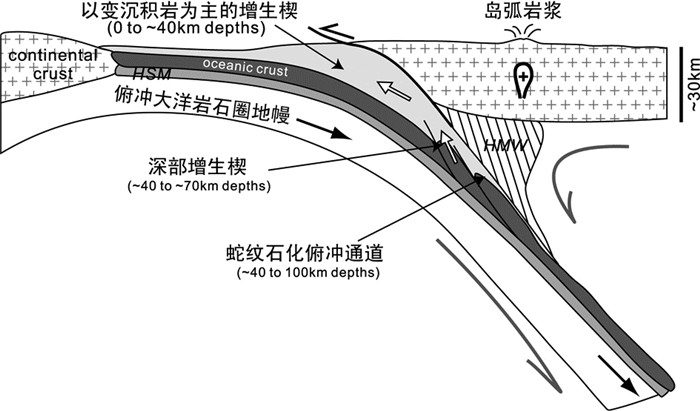
|
图 5 增生楔携带洋壳榴辉岩折返模式图(据Agard et al., 2009) HMW为富水的地幔楔; HSM为富水的俯冲岩石圈地幔(蛇纹岩层) Fig. 5 Schematic model for the exhumation of HP oceanic eclogites driven by the buoyant metasediments in accretionary wedge (after Agard et al., 2009) HMW-hydrated mantle wedge; HSM-hydrated slab mantle |
然而,一方面大洋俯冲带中变沉积岩的精准温压数据还不多,另一方面对其形成的构造背景(或在俯冲带中处于的结构部位) 还未完全明确。众所周知,增生楔的深度较浅,一般认为小于40km (Shreve and Cloos, 1986; Platt, 1986),Guillot et al.(2009)根据统计出露地表的增生楔中高压岩石的温压数据,提出深部增生楔可以达到70km的深度。但即使如此,增生楔携带榴辉岩折返模式仍不能解释深俯冲洋壳(尤其超高压洋壳榴辉岩) 的抬升过程。近年来HP-UHP变沉积岩的研究结果,暗含以下两种可能的解释:(1) 我们可能低估了增生楔的深度,它可能同样达到了100km的深度;或(2) 部分沉积盖层并没有堆积在浅部增生楔中,它随俯冲洋壳一起经历了HP-UHP变质,然后折返回地表。到目前为止,超深增生楔(~100km) 还缺乏地球物理观测数据的支持,因此笔者更倾向于第二种解释。高温高压实验和模拟计算研究表明,变沉积岩即使俯冲到200km的深度,其密度仍小于周围地幔值(Irifune et al., 1994; Dobrzhinetskaya and Green, 2007; Wu et al., 2009)。但为何全球大洋俯冲带出露地表的变沉积岩和榴辉岩的折返深度几乎都未超过110km?是否是经历超深俯冲的变沉积岩的量太小,不足以平衡洋壳榴辉岩的负浮力?还是有另外一种机制阻碍了超深俯冲的变沉积岩和榴辉岩的折返?这些都需要系统的了解变沉积岩和榴辉岩在洋壳俯冲过程中的密度演化过程。
4.2 陆壳岩石携带折返模式当洋壳俯冲转换为陆壳俯冲,部分洋壳物质会与继续向深部俯冲的洋壳拆离,而随着低密度的陆壳岩石折返(Ernst, 2001; Chopin, 2003;Plunder et al., 2012)。这种模式的运用其实非常局限。众所周知,在大洋俯冲和大陆俯冲都有记录的造山带中,如我国的大别山造山带和柴北缘造山带,大洋板块俯冲一般早于大陆板块俯冲,洋壳岩石的折返时限也早于陆壳岩石(Song et al., 2006)。因此,只有位于大洋俯冲和大陆俯冲的转换带位置的洋壳岩石才有可能被折返的陆壳携带回地表,并且折返的时期也非常局限(大陆参与俯冲后的10~20Ma)(Agard et al., 2009)。折返的洋壳岩石也必然处于大陆俯冲碰撞造山带的环境,比如大别山造山带的熊店榴辉岩(Cheng et al., 2009, 2010, 2012)、柴北缘的沙柳河榴辉岩(Zhang et al., 2008; Zhang et al., 2008) 和French Massif Central中的Limousin榴辉岩(Berger et al., 2010)。然而,现今出露的洋壳榴辉岩普遍位于典型的大洋俯冲带,并且它们的折返时间则具有非常宽泛的范围,部分从大洋板块汇聚初期就开始折返,如Franciscan蓝片岩和榴辉岩(Ernst, 1988; Baldwin, 1996; Schneider et al., 2004);也有部分洋壳榴辉岩是在大陆地壳参与俯冲才开始折返,如Western Alps和New Caledonia榴辉岩(见Agard et al., 2009综述)。因此,目前很难用此种模式来解释所有洋壳榴辉岩的折返。
4.3 蛇纹岩携带折返模式蛇纹石密度极低(2.75g/cm3),在紧邻大洋俯冲板块之上是富水的地幔楔,其浅部主要由蛇纹岩或蛇纹石化的橄榄岩组成(Guillot et al., 2001, 2009; Savov et al., 2005, 2007)。Hermann et al.(2000)发现洋壳榴辉岩的峰期温压条件几乎都在蛇纹石稳定域以内,结合在西阿尔卑斯造山带发现了大量的蛇纹岩中包裹洋壳榴辉岩的现象,因此建立了低密度的蛇纹岩携带俯冲洋壳物质折返模式。此种模式在今后的十几年内被不断深化,并得到了大量的数值模拟的论证(Guillot et al., 2001, 2009; Schwartz et al., 2001; Gerya et al., 2002; Gorczyk et al., 2007; Blanco-Quintero et al., 2010; Malatesta et al., 2012)。这些研究表明,在俯冲洋壳之上有一蛇纹石化的俯冲通道(serpentinized subduction channel),由于其密度低于周围地幔而形成“回流”(return flow),部分洋壳榴辉岩与俯冲洋壳拆离,沿此俯冲通道折返(图 6)。通常情况下,这种模式只能应用于有蛇纹岩伴生的洋壳榴辉岩,如Western Alps的Zermatt-Saas榴辉岩(Bucher et al., 2005; Angiboust and Agard, 2010),但无法解释几乎没有蛇纹岩伴生的洋壳榴辉岩的折返,如Ecuador榴辉岩(Kerr et al., 2002)、Dominican Republic榴辉岩(Krebs et al., 2008) 以及我国的西南天山和北祁连榴辉岩(Song et al., 2006; Zhang et al., 2008; Lü et al., 2009; Cao et al., 2011)。
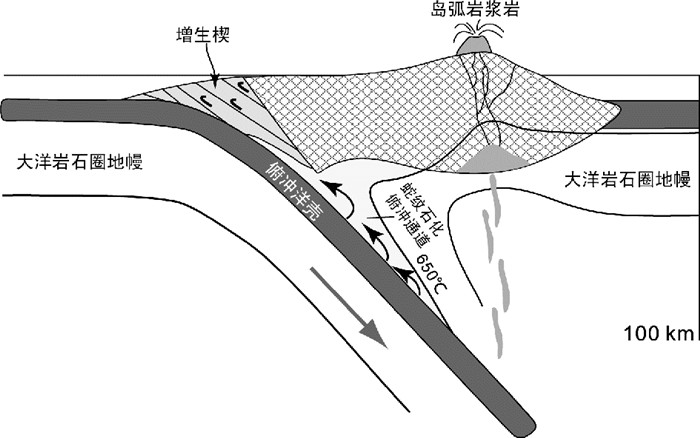
|
图 6 HP-UHP洋壳榴辉岩沿蛇纹石化俯冲通道折返模式(据Guillot et al., 2009) Fig. 6 Schematic model for the exhumation of HP-UHP oceanic eclogites along the serpentinized subduction channel (after Guillot et al., 2009) |
以上这些模式都注重了与洋壳榴辉岩伴生的低密度岩石的作用,但忽略了俯冲洋壳主体(洋壳榴辉岩) 的密度演化。准确揭示俯冲洋壳的折返机制,必须先明确俯冲洋壳在深部与周围地幔的密度对比关系。建立俯冲洋壳的相平衡关系,尤其是确立不同地温梯度的俯冲洋壳中低密度含水矿物的稳定性,成为解决这一科学问题的关键。
5 俯冲洋壳的密度演化俯冲洋壳的密度演化一般都是通过高温高压实验结合热力学计算来获得的。首先通过实验来限定俯冲洋壳的相关系,然后根据单矿物的零压密度(ρ0) 和相关的弹性参数,根据Birch-Murnaghan (HTBM) 公式进行温度和压力校正,再结合单矿物占全岩的比例,可计算出全岩在相应温度和压力条件下的密度(如Litasov and Ohtani, 2005; Wu et al., 2009)。然而,通过高温高压实验限定的俯冲洋壳密度演化曲线仍有两点不足:(1) 实验温度太高,不能反映冷俯冲洋壳的密度演化;(2) 没有充分考虑矿物成分对岩石密度的影响,即在不同全岩体系或不同温压条件下,都假设单矿物具有相同的化学成分和零压密度。因此,正确反演俯冲洋壳的密度演化还需借助其它研究手段。
岩石的密度与岩石的矿物组成、矿物含量和成分、温度、压力、矿物的各种弹性模量等因素有关。因此,只需要明确洋壳榴辉岩的矿物组成和各矿物的弹性模量,即可通过理论计算获得相应温压条件下的洋壳密度。THERMOCALC程序(Powell et al., 1998) 是用来计算已知全岩成分或者成分范围体系相平衡关系的强大工具,它可以计算给定温压条件下岩石体系达到平衡的矿物组合、矿物含量和成分(Powell and Holland, 2008),它已被广泛应用于变质岩石学领域。此外,岩石物理学家可通过热力学状态方程和矿物的弹性参数来计算给定温压条件下的矿物密度(Hacker et al., 2003a; Simon and Podladchikov, 2008; Wu et al., 2009)。因此,结合这两种计算方法,即可获得已知岩石体系中任意温压条件下岩石的密度,具体的计算方法详见Chen et al.(2013c)。这种联合计算方法充分考虑了温度、压力、矿物成分和含量对全岩密度的影响,它不仅为建立俯冲洋壳浅部的密度演化提供新的研究手段,也为岩石学和地球物理两个学科建立了良好的桥梁。
Chen et al.(2013c)通过MORB平均成分计算了1~4GPa和400~800℃范围内的相平衡关系(图 7) 和密度剖面(图 8)。由于不同的俯冲洋壳具有不同的地温梯度(Peacock and Wang, 1999; Kirby, 2000),因此我们参照冷俯冲(~6℃/km) 和热俯冲(~10℃/km) 两种不同的P-T轨迹来探讨俯冲洋壳的变质和密度演化(图 7)。结果显示,在冷俯冲和热俯冲两种地温曲线演化条件下,俯冲洋壳的矿物组合、矿物成分、矿物含量和密度有显著差异,并且洋壳榴辉岩的密度主要受低密度含水矿物(如硬柱石、绿泥石、蓝闪石和滑石) 的稳定性控制。若洋壳经历冷俯冲(~6℃/km),它会由蓝片岩相矿物组合(绿辉石+蓝闪石+硬柱石+绿泥石+多硅白云母±滑石+石英) 向榴辉岩相矿物组合(石榴石+绿辉石+硬柱石+多硅白云母±滑石±绿泥石±蓝闪石+石英/柯石英) 转变。其中低密度绿泥石、蓝闪石和滑石分别在2.3、2.6和3.6GPa条件下完全脱水分解,形成高密度的石榴石和绿辉石和低密度的流体。相应地,冷俯冲洋壳密度由3.12g/cm3(1.5GPa) 增加到3.46g/cm3(4GPa),由于低密度硬柱石和滑石可稳定到很高的压力,所以冷俯冲洋壳的密度增加较为缓慢。若洋壳经历热俯冲(~10℃/km),它会由角闪岩相矿物组合(角闪石+绿泥石+绿帘石±绿辉石+多硅白云母+石英) 向榴辉岩相矿物组合(石榴石+绿辉石+绿帘石±角闪石±蓝晶石+多硅白云母+石英/柯石英) 转变。其中绿泥石、绿帘石和角闪石分别在1.5、1.88、和1.9GPa条件下就完全脱水分解,导致整个岩石变干变重。相应地,热俯冲洋壳的密度由3.21g/cm3(1.2GPa) 急剧增加到3.45g/cm3(1.9GPa),然后缓慢增加到3.49g/cm3(3GPa)。由此可见,俯冲洋壳的密度主要受低密度含水矿物的稳定性控制。一旦发生脱水分解反应,岩石密度急剧增加(图 8)。由于冷俯冲洋壳中含水矿物可以稳定到相对较高的压力,所以在相同深度条件下其密度整体小于热俯冲洋壳的密度。
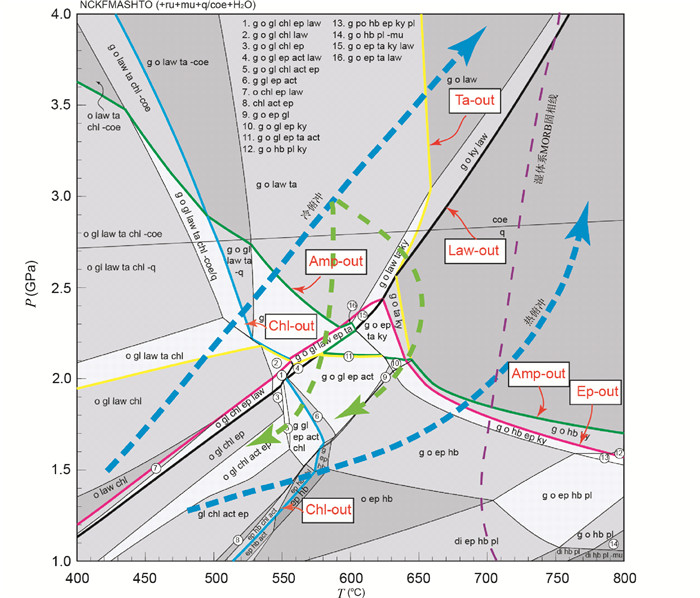
|
图 7 以平均MORB成分计算的P-T视剖面图(据Chen et al., 2013c) 图中两条篮色虚线代表两类俯冲P-T轨迹,两条绿色虚线代表两类折返P-T轨迹 Fig. 7 The calculated P-T pseudosection based on the average MORB composition (after Chen et al., 2013c) The two blue dashed lines represent two types of subduction P-T path, whereas another two green dashed lines denote two types of exhumation P-T path |
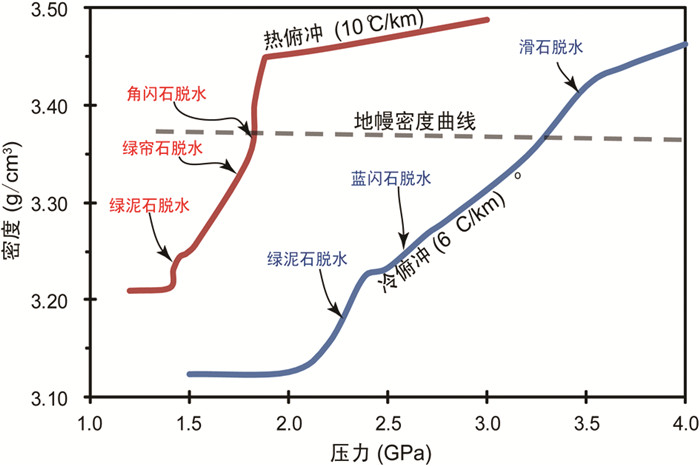
|
图 8 洋壳沿冷热两种P-T轨迹俯冲的密度演化曲线 PREM (Dziewonski and Anderson, 1981) 为周围地幔密度 Fig. 8 The calculated density profiles of the subducted oceanic crust along the cold and warm subductions shown in Fig. 7 The density profile of mantle derived from PREM (Dziewonski and Anderson, 1981) is also shown |
俯冲带中HP-UHP岩石的折返通常与浮力作用有关(Davies and von Blanckenburg, 1995; Ernst et al., 1997; Ernst, 2001, 2005, 2006; Guillot et al., 2009)。在俯冲过程中,密度比周围地幔低的HP-UHP岩石有机会从俯冲板块拆离下来,折返至下地壳深度(Ernst, 2001; 2006)。地幔密度随深度的演化关系一般都参照由Dziewonski and Anderson (1981)提出的初步参考地球模型(Preliminary Reference Earth Model,PREM)(如Aoki and Takahashi, 2004; Litasov and Ohtani, 2005; Hirose et al., 2005; Perrillat et al., 2006; Wu et al., 2009)。因此,俯冲地壳HP-UHP岩石和PREM的密度对比能为HP-UHP岩石的折返提供重要的约束。比如俯冲长英质陆壳物质在 < 7.5GPa条件下的密度一直小于周围地幔,因此俯冲到~250km深度的陆壳HP-UHP岩石可由浮力作用而折返(Wu et al., 2009)。这种模式已被广泛应用于解释俯冲大陆上地壳HP-UHP岩石的折返(Davies and von Blanckenburg, 1995; Ernst, 2001, Wu et al., 2009; Zhao et al., 2011)。
我们也可以对比俯冲基性洋壳和PREM密度来限定洋壳榴辉岩的折返深度。图 8显示经历冷俯冲(~6℃/km) 的洋壳密度在 < 110km深度下始终小于周围地幔密度,这表明冷俯冲洋壳形成的低温榴辉岩在 < 110km的深度可以由浮力作用而折返,而>110km深度形成的洋壳榴辉岩则由负浮力作用继续向深部地幔俯冲。然而,经历热俯冲(~10℃/km) 的洋壳在~1.9GPa就已经转变为干热榴辉岩,因此它的密度在>~60km的深度就已经大于周围地幔(图 8),不能由自身浮力作用折返。同样,我们可以运用此种计算方法限定不同地温梯度的俯冲洋壳的最大折返深度,将这些最大折返深度连接起来,即可获得俯冲洋壳的折返深度曲线(如图 3红线)。如图 3所示,红线的左边代表俯冲洋壳密度小于周围地幔,浮力为正值,可以折返;红线的右边代表俯冲洋壳密度大于周围地幔,浮力为负值,不能自行折返。结合全球洋壳榴辉岩的峰期温压条件,不难发现,它们全都位于浮力正值的可折返区域。由于俯冲洋壳的地温梯度一般都认为>=5℃/km (如Agard et al., 2009; Brovarone et al., 2011; Endo et al., 2012),因此俯冲洋壳能够折返的最大深度为 < 120km ( < 3.6GPa)。这可能是现今折返的洋壳榴辉岩都为冷的富水榴辉岩,并且其形成深度都不超过110km的主要原因。此外,图 8还显示,能够继续向深部俯冲的洋壳榴辉岩有两类。一类是形成深度>110~120km的含硬柱石UHP榴辉岩(低温富水榴辉岩),它可以携带大量的H2O进入深部地幔,是深部流体的主要源区,直到~300km的地幔深度硬柱石才完全分解消失(Schmidt and Poli, 1998; Okamoto and Maruyama, 1999)。Colorado高原的金伯利岩中的含硬柱石榴辉岩的包体(~4.0GPa,630℃;Usui et al., 2003, 2006) 可能就是此类循环至深部地幔的高密度UHP硬柱石榴辉岩。另一类是形成深度>~60km的高温榴辉岩,因为它的密度大于周围地幔值,因此不能折返,这可能是为何现今折返的洋壳榴辉岩中没有发现高温榴辉岩的主要原因。地球物理探测发现的过渡地幔(Zhao et al., 2007; Zhao, 2008)、下地幔(Fukao et al., 2001) 以及核幔边界(Hirose et al., 2005) 的洋壳物质可能就是此类高温榴辉岩。
6.2 蛇纹岩和变沉积岩对洋壳榴辉岩折返的影响深度洋壳榴辉岩常与蛇纹岩、变沉积岩、基性蓝片岩组成蛇绿混杂岩,可作为洋壳俯冲的经典标志。而蛇纹岩(Hermann et al., 2000)、变沉积岩(Wei et al., 2009b) 和基性蓝片岩(Chen et al., 2013c) 都具有低于周围地幔的密度值,因此它们这些低密度岩石对洋壳榴辉岩的抬升可能有重要的贡献。本文只对蛇纹岩和变沉积岩阐述初步的看法。
西阿尔卑斯造山带是全球最为经典的俯冲带之一,这里发育了大规模的蛇纹岩,成为研究俯冲洋壳折返机制的良好区域。众多学者以西阿尔卑斯为例,提出蛇纹石化的俯冲通道携带洋壳榴辉岩折返模式(Hermann et al., 2000; Schwartz et al., 2001; Guillot et al., 2001, 2009; Agard et al., 2009; Angiboust and Agard, 2010; Angiboust et al., 2012)。然而,应用此模式必须先要充分理解蛇纹岩在俯冲带所处的构造背景,它能够影响榴辉岩折返的深度是多少?大量的地球物理观测资料表明,蛇纹岩在大洋俯冲带处于两个构造部位,一是位于紧邻俯冲基性洋壳之下的低温富水岩石圈地幔(Hacker et al., 2003b; Zhang et al., 2004),二是位于紧邻俯冲基性洋壳之上的浅部富水低温地幔楔(Savov et al., 2005, 2007; Guillot et al., 2009)。由于现今折返的洋壳榴辉岩都是低温富水的榴辉岩,并且只是以透镜体形式包裹于变沉积岩和蛇纹岩中,说明只有部分的基性洋壳与俯冲板块拆离而折返到地表。变沉积岩原为俯冲洋壳表皮的大洋沉积物,而蛇纹岩主要来自于低温地幔楔(Guillot et al., 2001, 2009; Scambelluri et al., 2001; Fitzherbert et al., 2004; Hattori and Guillot, 2007),并且部分洋壳榴辉岩仍保存了枕状结构,因此可以推测折返的洋壳榴辉岩主要从俯冲洋壳的表皮拆离下来的。而俯冲洋壳本身同样存在着温度差别,俯冲洋壳的表皮温度较高,其底部温度较低(Peacock and Wang, 1999; Kirby, 2000)。数值模拟计算表明,对应岛弧之下的俯冲洋壳表皮温度在650~1000℃之间(Syracuse et al., 2010),在125km深度的俯冲洋壳表皮温度在750~1000℃之间(图 9)(van Keken et al., 2011)。蛇纹石是典型的低温高压矿物,大量实验研究表明蛇纹石在>650℃条件下完全脱水分解(Fumagalli and Poli, 2005; Padron-Navarta et al., 2010),而紧邻俯冲洋壳之上的富水地幔楔温度与洋壳表皮温度相似。因此,蛇纹岩不能稳定于岛弧之下的地幔楔,只能稳定存在于弧前盆地之下的浅部地幔楔。假如洋壳经历冷俯冲(~5~8℃/km),则蛇纹石稳定的压力不能超过2.7~3.7GPa (图 3),对应90~120km。换言之,超过120km深度以后,就不存在蛇纹石化的俯冲通道。
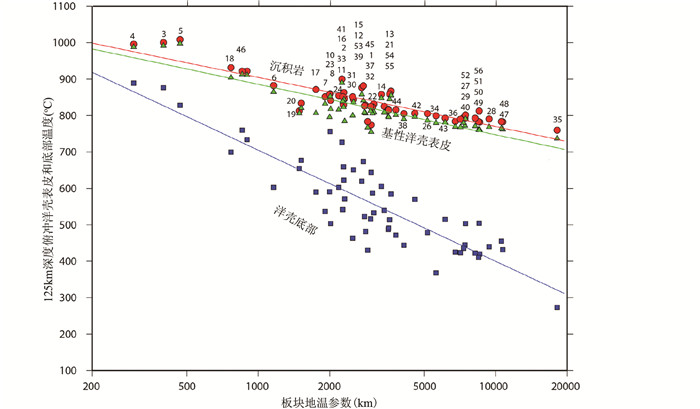
|
图 9 全球俯冲洋壳表皮和底部的温度差异(据van Kenken et al., 2011) 图中的数字编号对应不同的俯冲带,俯冲板块地温参数参照Kirby et al. (1991) Fig. 9 Temperature discrepancy between the top and bottom parts of subducted oceanic crust worldwide Numbers in this figure refers to different subduction zones. The slab thermal parameter is after Kirby et al. (1991) |
变沉积岩一般在大洋俯冲带中出露面积最广,其密度较低,但目前对于其密度的实验和模拟研究并不是很多。Wei et al.(2009b)针对南天山石榴石-蓝闪石片岩进行了相平衡模拟研究,指出其在2.3~3.2GPa条件下密度为2.93~3.08g/cm3,远小于地幔密度。俯冲洋壳表层的沉积盖层厚度一般约为400m (Michard et al., 1996),俯冲基性洋壳厚度一般约5~7km (van Keken et al., 2011)。而目前折返到地表的洋壳物质却以变沉积岩为主,Agard et al.(2009)曾对折返的沉积岩和基性洋壳岩石作出体积估算,发现大约有30%~50vol%的沉积物已折返至地表,而只有 < 5vol%的基性洋壳岩石折返至地表。这表明基性洋壳的主体部分都向深部俯冲了。如前文所述,变沉积岩主要在增生楔中堆积,而增生楔一般深度又小于70km (Guillot et al., 2009)。因此,以变沉积岩为主的增生楔可能只对浅部( < 70km) 洋壳榴辉岩的抬升有促进作用。现今在西南天山所发现的UHP石榴石-蓝闪石片岩(Wei et al., 2009b) 可能不是增生楔中的物质,它与其包裹的洋壳榴辉岩透镜体共同经历了深俯冲(超过增生楔深度) 和折返过程,并对洋壳榴辉岩的折返起到了重要的促进作用。由于沉积物俯冲到200km的深度,其密度仍小于周围地幔(Irifune et al., 1994; Dobrzhinetskaya and Green, 2007; Wu et al., 2009),因此从理论上可以推测变沉积岩可以携带>120km深度的高密度榴辉岩折返。然而,为何目前已折返的洋壳变沉积岩和榴辉岩的形成深度都未超过110km?是何原因阻碍了超深俯冲的变沉积岩携带榴辉岩折返?
为此,笔者搜集了全球多个大洋俯冲带的地震学剖面,发现在60~120km深度俯冲大洋板块的俯冲角度都有明显的突然增大,比如Central Andes (Yuan et al., 2000)、Cascadia (Abers et al., 2009)、Aleutians (Yamasaki and Seno, 2003)、Alaska (Rondenay et al., 2008)、Nicaragua (MacKenzie et al., 2010)、Costa Rica (MacKenzie et al., 2010) 和台湾(Yamasaki and Seno, 2003) 等地区的大洋俯冲带。众多研究学者认为,这种俯冲角度增大主要与俯冲洋壳的脱水(榴辉岩化) 作用有关(如Yuan et al., 2000; Rondenay et al., 2008; van Keken et al., 2011; Klemd et al., 2011)。当洋壳俯冲超过增生楔深度,俯冲洋壳的主体为基性洋壳(>90vol%)。由于浅部的俯冲洋壳水含量和含水矿物含量较高,粘滞度较小;而深部俯冲洋壳水含量和含水矿物含量低,粘滞度较大。因此,低密度含水矿物脱水分解不仅会导致洋壳密度急剧增大(图 8),而且还导致洋壳逐渐由塑性向脆性转变(Yamasaki and Seno, 2003; Jolivet et al., 2005; John et al., 2009)。一旦在某一深度俯冲洋壳密度超过周围地幔,由于其浅部的洋壳偏塑性并且浮力为正,而深部的洋壳偏脆性并且浮力为负,两种不同方向的作用力和不同的流变学性质,即可导致俯冲板块角度增大。而俯冲角度增大的“拐点”即为俯冲洋壳密度超过周围地幔的临界点。根据本文相平衡模拟结果,冷俯冲基性洋壳在>110~120km条件下密度大于周围地幔,而热俯冲基性洋壳在>60km条件下密度就已经大于周围地幔(图 8)。这与现今大洋俯冲板块的“拐点”深度相一致,“拐点”深度的不同则可能反映了俯冲地温梯度的差异。值得注意的是,俯冲板块的角度增大在几何形态上很可能阻碍了更深部位的HP-UHP岩石的折返(Klemd et al., 2011)。比如部分俯冲洋壳物质可能在“拐点”处堆积,从而阻碍更深部的岩石(如低密度变沉积岩携带高密度榴辉岩透镜体) 折返(图 10)。这可能是为何目前已折返的洋壳变沉积岩和榴辉岩的形成深度几乎都未超过110km的原因之一。
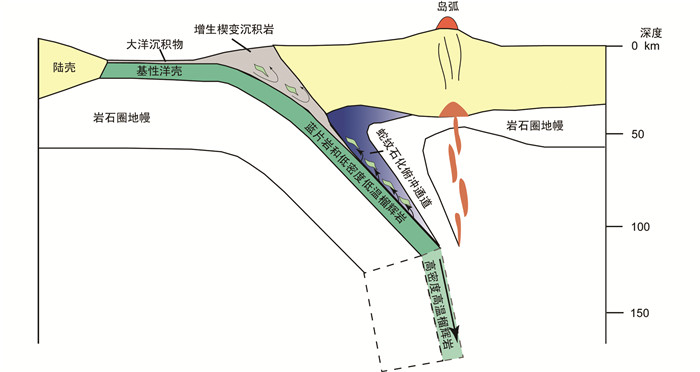
|
图 10 冷俯冲带洋壳榴辉岩(和蓝片岩、变沉积岩) 的折返模式简图(据Guillot et al., 2009修改) 在 < 70km的深度,低密度低温富水榴辉岩和蓝片岩由增生楔变沉积岩携带折返地表,在 < 110~120km (弧前之下区域),低密度的低温富水榴辉岩(和蓝片岩、变沉积岩) 与俯冲板块拆离,并沿蛇纹石化俯冲通道折返(Gerya et al., 2002; Gorczyk et al., 2007; Guillot et al., 2009; Malatesta et al., 2012).而更深部的(比如岛弧之下区域) 高密度高温榴辉岩继续向深部俯冲,由于其密度高于周围地幔,可能导致俯冲板块角度增大,从而阻碍>120km深度的变沉积岩和榴辉岩折返 Fig. 10 Schematic model for the exhumation of oceanic eclogites (and blueschists) in a cold oceanic subduction zone (modified after Guillot et al., 2009) At depths < 70km, the light blueschists and cold-hydrous eclogites are dragged by the exhumed metasedimentary rocks in the accretionary wedge. In the forearc region ( < 110~120km), the light blueschists and cold-hydrous eclogites (and also metasediments) are detached from the top of the subducting slab and are exhumed inside serpentinized subduction channel by return channel flow (Gerya et al., 2002; Gorczyk et al., 2007; Guillot et al., 2009; Malatesta et al., 2012). The dense-hot eclogites formed at greater depth (e.g. beneath the arc) are denser than the mantle and thus are expected to sink into deeper mantle. The transporting material in the subduction channel may pinch out at the kink, inhibiting exhumation of rocks from greater depth |
综上所述,在>120km的深度,(1) 俯冲基性洋壳密度大于周围地幔;(2) 蛇纹石化的俯冲通道无法稳定;(3) 大洋板块的俯冲角度突然增大可能阻碍了更深部的低密度变沉积岩的折返。以上这三个方面的原因可能导致现今折返到地表的洋壳榴辉岩和变沉积岩的形成深度普遍小于110km。
6.3 洋壳折返过程中的密度演化HP绿帘石榴辉岩是大洋俯冲带分布最为常见的榴辉岩类型,通常认为它是HP硬柱石榴辉岩的退变质产物(如Sivrihisar Massif, Turkey, Davis and Whitney, 2006; Wei and Clarke, 2011) 或者热俯冲洋壳变质产物(如日本Sanbagawa造山带, Wallis et al., 2000; Kabir and Takasu, 2010)。含硬柱石的洋壳榴辉岩其实并不常见,硬柱石是俯冲洋壳中主要的高压含水矿物,它在洋壳折返过程中极容易发生脱水分解而难以保存(Wei et al., 2009a; Wei and Clark, 2011),形成含绿帘石的硬柱石假象组合,包括绿帘石+蓝晶石+石英/柯石英、绿帘石+钠云母+石英和绿帘石+蓝闪石+石英(如Ballevre et al., 2003; Tsujimori et al., 2006a; Groppo and Castelli, 2010; Wei and Clarke, 2011; Guo et al., 2013)。然而,蓝晶石榴辉岩在大洋俯冲带中并无出露,而绿帘石-钠云母榴辉岩和绿帘石-蓝闪石榴辉岩在全球大洋俯冲带中极为常见(表 1)。相平衡模拟结果显示,蓝晶石是典型的高压高温矿物,它的形成主要受控于硬柱石的分解(图 7)。由于绿帘石和蓝晶石都属于高密度矿物,而硬柱石密度较低(图 4),因此有理由推测洋壳折返过程中的硬柱石分解有可能导致岩石密度增大,从而有可能阻碍洋壳榴辉岩的折返。
据前文所述,洋壳榴辉岩的折返P-T轨迹大致可分为三类,降温降压型通常都位于硬柱石稳定域内,在此不作考虑。而近等温降压型(isothermal decompression,ITD) 和降压升温型(heating decompression)P-T轨迹可以穿过硬柱石稳定域,进入绿帘石和蓝晶石稳定域,因此只需要考虑这两种情况即可。我们假设一个UHP硬柱石榴辉岩的峰期温压条件为3.0GPa和580℃(与西阿尔卑斯的Zermatt-Saas UHP榴辉岩峰期温压条件相似)。若经历近等温降压型折返P-T轨迹,硬柱石发生的分解反应为law+o=gl+ep+q+H2O,导致岩石密度由峰期的3.30g/cm3上升到3.34g/cm3(图 11),但是仍然小于周围地幔的密度。这可能是由于分解反应形成了低密度的蓝闪石和石英,从而缓冲了岩石密度的过分增长。若岩石经历降压升温的折返P-T轨迹,硬柱石发生的分解反应为law+o+ta=g+ky+q+H2O,导致岩石密度由3.30g/cm3快速增长到3.47g/cm3,大于周围地幔密度值。这是因为反应消耗了低密度矿物硬柱石和滑石,而产生了高密度的石榴石和蓝晶石。因此,洋壳折返过程中,硬柱石发生分解反应而形成蓝晶石,会导致榴辉岩密度急剧增长并高于周围地幔密度,从而阻碍了洋壳榴辉岩的折返,可以推测含蓝晶石的榴辉岩仍在深部地幔,无法折返。这可能是为何全球洋壳榴辉岩中普遍缺失蓝晶石的主要原因。值得注意的是,欧洲French Massif Central的Limousin蓝晶石榴辉岩和我国柴北缘的沙柳河蓝晶石榴辉岩都处于大陆俯冲碰撞造山带的背景(Zhang et al., 2008; Berger et al., 2010),它们的抬升可能与陆壳物质的折返过程有关。
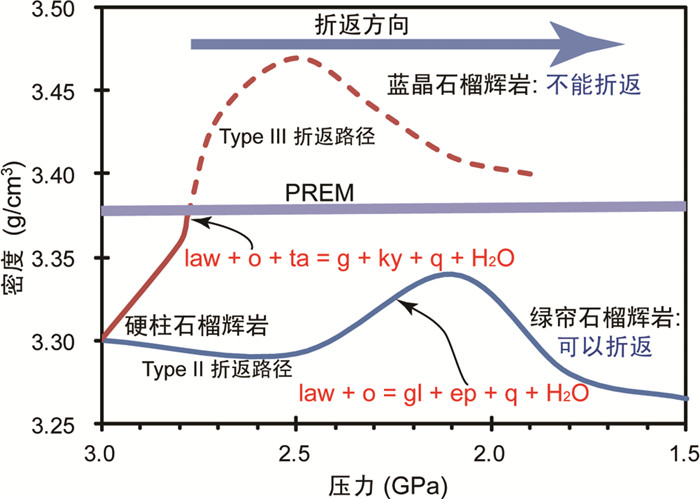
|
图 11 冷俯冲洋壳榴辉岩沿两种P-T轨迹(如图 7所示) 折返过程中的密度演化对比 PREM (Dziewonski and Anderson, 1981) 为周围地幔密度.在两种折返过程中,硬柱石都会发生脱水分解反应.生成的蓝晶石榴辉岩密度大于周围地幔,因而难以折返.Type Ⅱ exhumation-近等温降压;Type Ⅲ exhumation-升温降压 Fig. 11 Comparison of calculated density profiles of the oceanic crust along two exhumation P-T paths shown in Fig. 7, with respect to the density profile derived from PREM (Dziewonski and Anderson, 1981) During the both exhumation P-T paths, lawsonite breakdown reactions would happen. The produced kyanite eclogite becomes denser than the surrounding mantle and thus is hard to exhume back to crustal level. Type Ⅱ exhumation-isothermal decompression; Type Ⅲ exhumation-heating decompression |
(1) 全球出露三十多处典型的洋壳HP-UHP榴辉岩,都呈透镜体包裹于变沉积岩或蛇纹岩中,其形成深度不超过110km,为低温富水的榴辉岩(T < 650℃)。与大陆俯冲碰撞造山带的榴辉岩相比,洋壳榴辉岩不含蓝晶石,含有较多的低密度含水矿物。
(2) 根据洋壳榴辉岩的峰期矿物组合和温压条件,可将其分成三类:含柯石英UHP榴辉岩、HP硬柱石榴辉岩和HP绿帘石榴辉岩。它们分别对应不同的形成深度和地温梯度,有时可在同一个造山带中同时出露UHP榴辉岩和HP硬柱石/绿帘石榴辉岩,说明它们可能从不同的深度折返,或者从俯冲洋壳不同的部位折返。
(3) 增生楔变沉积岩携带折返模式和蛇纹岩携带折返模式被学者广泛接受,然而它们都存在一些尚未解决的深层次问题。如为何全球洋壳变沉积岩和榴辉岩的折返深度都未超过110km?现有的这些模式都注重了与洋壳榴辉岩伴生的低密度岩石的作用,但忽略了俯冲基性洋壳本身的密度演化。
(4) MORB体系的相平衡模拟研究结果显示,洋壳榴辉岩的密度主要受低密度含水矿物(如硬柱石、绿泥石、蓝闪石和滑石) 的稳定性控制。若洋壳经历冷俯冲(~6℃/km),硬柱石可一直稳定到>4GPa,绿泥石、蓝闪石和滑石可以分别稳定到2.3、2.6和3.6GPa,并且,俯冲洋壳的密度在 < 110~120km的深度(P < 3.3~3.6 GPa) 始终小于周围地幔,这表明若无其他低密度岩石的影响,洋壳榴辉岩能够靠自身浮力折返的最大深度为110~120km。然而,若洋壳经历热俯冲(~10℃/km),俯冲轨迹位于硬柱石稳定域之外,含水矿物绿泥石、绿帘石和角闪石分别在较低压力1.5、1.85和1.9GPa就完全分解,并且,俯冲洋壳的密度在>60km的深度(P>1.8GPa) 就高于周围地幔。因此,热俯冲的洋壳榴辉岩能够靠自身浮力折返折返的最大深度为~60km。
(5) 由于洋壳榴辉岩都以透镜体包裹于变沉积岩和地幔楔蛇纹岩中,所以已折返的洋壳榴辉岩主要从俯冲洋壳的表皮拆离下来的。根据高温高压实验数据和数值模拟结果,我们推测超过120km深度以后,蛇纹石不能在地幔楔中稳定,因此不存在蛇纹岩化的俯冲通道,蛇纹岩只能在 < 120km的深度才能对洋壳榴辉岩的折返有促进作用。出露地表的变沉积岩大部分为蓝片岩相,以变沉积岩为主的增生楔可能只对浅部( < 70km) 洋壳榴辉岩的抬升有促进作用。仍有部分变沉积岩记录了UHP信息,说明它们可能与俯冲基性洋壳共同俯冲到了深部地幔然后共同折返。然而,由于俯冲基性洋壳在>60~120km的深度条件下密度大于周围地幔,造成俯冲大洋板块在60~120km的深度普遍存在俯冲角度突然增大的现象,出现“拐点”。部分俯冲洋壳物质可能在“拐点”处堆积,阻碍更深部低密度变沉积岩携带高密度榴辉岩透镜体折返。我们认为俯冲洋壳的最大折返深度不超过120km,这是因为在>120km条件下,俯冲基性洋壳本身密度大于周围地幔,而蛇纹石化的俯冲通道亦无法稳定,俯冲板块角度增大阻碍了更深部的低密度变沉积岩携带榴辉岩折返。
(6) 洋壳折返过程中的硬柱石分解导致岩石密度增大,若从UHP硬柱石榴辉岩区域开始折返,退变形成绿帘石-蓝闪石榴辉岩,其密度小于周围地幔,可以折返;若退变形成蓝晶石榴辉岩,其密度大于周围地幔,无法折返。这可能是为何全球洋壳榴辉岩中普遍缺失蓝晶石的主要原因。
本文对俯冲洋壳的折返研究现状和相关问题讨论都是浮浅的,很多重要的问题以目前的研究程度还无法回答,仅希望为进一步深入研究提供一点体会和建议。
致谢 感谢金振民院士、翟明国院士、张立飞教授、魏春景教授、刘景波研究员、Taras V. Gerya教授的批评指正,同时也感谢吴耀博士和Eleanor Green博士的帮助和讨论。| [] | Abers GA, MacKenzie LS, Rondenay S, Zhang Z, Wech AG, Creager KC. 2009. Imaging the source region of Cascadia tremor and intermediate-depth earthquakes. Geology, 37(12): 1119–1122. DOI:10.1130/G30143A.1 |
| [] | Agard P, Jolivet L, Goffé B. 2001. Tectonometamorphic evolution of the schistes Lustrés complex: Implications for the exhumation of HP and UHP rocks in the Western Alps. Bull. Soc. Geol. Fr., 172(5): 617–636. DOI:10.2113/172.5.617 |
| [] | Agard P, Yamato P, Jolivet L, Burov E. 2009. Exhumation of oceanic blueschists and eclogites in subduction zones: Timing and mechanisms. Earth-Sci. Rev., 92(1-2): 53–79. DOI:10.1016/j.earscirev.2008.11.002 |
| [] | Altherr R, Topuz G, Marschall H, Zack T, Ludwig T. 2004. Evolution of a tourmaline-bearing lawsonite eclogite from the Elekdag area (Central Pontides, N Turkey): Evidence for infiltration of slab-derived B-rich fluids during exhumation. Contrib. Mineral. Petrol., 148(4): 409–425. DOI:10.1007/s00410-004-0611-1 |
| [] | Angiboust S, Agard P. 2010. Initial water budget: The key to detaching large volumes of eclogitized oceanic crust along the subduction channel?. Lithos, 120(3-4): 453–474. DOI:10.1016/j.lithos.2010.09.007 |
| [] | Angiboust S, Langdon R, Agard P, Waters D, Chopin C. 2012. Eclogitization of the Monviso ophiolite (W. Alps) and implications on subduction dynamics. J. Metamorph. Geol., 30(1): 37–61. |
| [] | Aoki I, Takahashi I. 2004. Density of MORB eclogite in the upper mantle. Phys. Earth Planet. Inter., 143: 129–143. |
| [] | Baldwin S. 1996. Contrasting P-T-t histories for blueschists from the Western Baja Terrane and the Aegean: Effects of synsubduction exhumation and backarc extension. In: Bebout GE et al. (eds.). Subduction: Top to Bottom. Geophys. Mon., AGU, 135-141 |
| [] | Ballevre M, Pitra P, Bohn M. 2003. Lawsonite growth in the epidote blueschists from the Ile de Groix (Armorican Massif, France): A potential geobarometer. J. Metamorph. Geol., 21: 723–735. DOI:10.1046/j.1525-1314.2003.00474.x |
| [] | Berger J, Femenias O, Ohnenstetter D, Bruguier O, Plissart G, Mercier JCC, Demaiffe D. 2010. New occurrence of UHP eclogites in Limousin (French Massif Central): Age, tectonic setting and fluid-rock interactions. Lithos, 118(3-4): 365–382. DOI:10.1016/j.lithos.2010.05.013 |
| [] | Blanco-Quintero IF, García-Casco A, Gerya TV. 2010. Tectonic blocks in serpentinite mélange (eastern Cuba) reveal large-scale convective flow of the subduction channel. Geology, 39(1): 79–82. |
| [] | Bosch D, Gabriele P, Lapierre H, Malfere JL, Jaillard E. 2002. Geodynamic siginficance of the Raspas Metamorphic Complex (SW Ecuador): Geochemical and isotopic constraints. Tectonophysics, 345(1-4): 83–102. DOI:10.1016/S0040-1951(01)00207-4 |
| [] | Brovarone AV, Groppo C, Hetényi G, Compagnoni R, Malavieille J. 2011. Coexistence of lawsonite-bearing eclogite and blueschist: Phase equilibria modelling of Alpine Corsica metabasalts and petrological evolution of subducting slabs. J. Metamorph. Geol., 29(5): 583–600. DOI:10.1111/jmg.2011.29.issue-5 |
| [] | Bucher K, Fazis Y, De Capitani C, Grapes R. 2005. Blueschists, eclogites, and decompression assemblages of the Zermatt-Saas ophiolite: High-pressure metamorphism of subducted Tethys lithosphere. Am. Mineral., 90(5-6): 821–835. DOI:10.2138/am.2005.1718 |
| [] | Cao Y, Song SG, Niu YL, Jin ZM. 2011. Variation of mineral composition, fabric and oxygen fugacity from massive to foliated eclogites during exhumation of subducted ocean crust in the North Qilian suture zone, NW China. J. Metamorph. Geol., 29(7): 699–720. DOI:10.1111/j.1525-1314.2011.00937.x |
| [] | Carswell DA, O'Brien PJ, Wilson RN, Zhai M. 1997. Thermobarometry of phengite-bearing eclogites in the Dabie Mountains of central China. J. Metamorph. Geol., 15(2): 239–252. DOI:10.1111/jmg.1997.15.issue-2 |
| [] | Carswell DA and Compagnoni R. 2003. Introduction with review of the definition, distribution and geotectonic significance of ultrahigh pressure metamorphism. In: Carswell DA and Compagnoni R (eds.). Ultrahigh Pressure Metamorphism. Budapest: Eotvos University Press, 3-9 |
| [] | Chalot-Prat F, Ganne J, Lombard A. 2003. No significant element transfer from the oceanic plate to the mantle wedge during subduction and exhumation of the Tethys lithosphere (Western Alps). Lithos, 69(3-4): 69–103. DOI:10.1016/S0024-4937(03)00047-1 |
| [] | Chen Y, Ye K, Liu JB, Sun M. 2006. Multistage metamorphism of the Huangtuling granulite, Northern Dabie Orogen, eastern China: Implications for the tectonometamorphic evolution of subducted lower continental crust. J. Metamorph. Geol., 24(7): 633–654. DOI:10.1111/jmg.2006.24.issue-7 |
| [] | Chen Y, Ye K, Liu JB, Sun M. 2008. Quantitative P-T-X constraints on orthopyroxene-bearing high-pressure granulites in felsic-metapelitic rocks: Evidence from the Huangtuling granulite, Dabieshan Orogen. J. Metamorph. Geol., 26(1): 1–15. |
| [] | Chen Y, Ye K, Guo S, Wu TF and Liu JB. 2013a. Multistage metamorphism of garnet orthopyroxenites from the Maowu mafic-ultramafic complex, Dabieshan UHP terrane, eastern China. Int. Geol. Rev., doi:10.1080/00206814.2013.772694 |
| [] | Chen Y, Ye K, Wu YW, Guo S, Su B and Liu JB. 2013b. Hydration and dehydration in the lower margin of a cold mantle wedge: Implications for crust-mantle interactions and petrogeneses of arc magmas. Int. Geol. Rev., doi:10.1080/00206814.2013.781732 |
| [] | Chen Y, Ye K, Wu TF and Guo S. 2013c. Exhumation of oceanic eclogites: Thermodynamic constraints on pressure, temperature, bulk composition and density. J. Metamorph. Geol., doi:10.1111/jmg.12033 |
| [] | Cheng H, King RL, Nakamura E, Vervoort JD, Zheng YF, Ota T, Wu YB, Kobayashi K, Zhou ZY. 2009. Transitional time of oceanic to continental subduction in the Dabie orogen: Constraints from U-Pb, Lu-Hf, Sm-Nd and Ar-Ar multichonometric dating. Lithos, 110(1-4): 327–342. DOI:10.1016/j.lithos.2009.01.013 |
| [] | Cheng H, DuFrane SA, Vervoort JD, Nakamura E, Zheng YF, Zhou ZY. 2010. Protracted oceanic subduction prior to continental subduction: New Lu-Hf and Sm-Nd geochronology of oceanic-type high-pressure eclogite in the western Dabie orogen. Am. Mineral., 95: 1214–1223. DOI:10.2138/am.2010.3307 |
| [] | Cheng H, Zhang C, Vervoort JD, Zhou ZY. 2012. New Lu-Hf and Sm-Nd geochronology constrains the subduction of oceanic crust during the Carboniferous-Permian in the Dabie orogen. J. Asian Earth Sci., 63: 139–150. |
| [] | Chopin C. 2003. Ultrahigh-pressure metamorphism: Tracing continental crust into the mantle. Earth Planet. Sci. Lett., 212(1-2): 1–14. DOI:10.1016/S0012-821X(03)00261-9 |
| [] | Churikova T, Dorendorf F, Wörner G. 2001. Sources and fluids in the mantle wedge below Kamchatka, Evidence from across-arc geochemical variation. J. Petrol., 42(8): 1567–1593. DOI:10.1093/petrology/42.8.1567 |
| [] | Clarke GL, Aitchison JC, Cluzel D. 1997. Eclogites and blueschists of the Pam Peninsula, NE New Caledonia: A reappraisal. J. Petrol., 38: 843–876. DOI:10.1093/petroj/38.7.843 |
| [] | Conrad CP, Bilek S, Lithgow-Bertelloni C. 2004. Great earthquakes and slab pull: Interaction between seismic coupling and plate-slab coupling. Earth Planet. Sci. Lett., 218(1-2): 109–122. DOI:10.1016/S0012-821X(03)00643-5 |
| [] | Davies JH, von Blanckenburg F. 1995. Slab breakoff: A model of lithosphere detachment and its test in the magmatism and deformation of collisional orogens. Earth Planet. Sci. Lett., 129(1-4): 85–102. DOI:10.1016/0012-821X(94)00237-S |
| [] | Davis PB, Whitney DL. 2006. Petrogenesis of lawsonite and epidote eclogite and blueschist, Sivrihisar Massif, Turkey. J. Metamorph. Geol., 24(9): 823–849. |
| [] | Davoudian AR, Genser J, Dachs E, Shabanian N. 2008. Petrology of eclogites from north of Shahrekord, Sanandaj-Sirjan Zone, Iran. Mineral. Petrol., 92(3-4): 393–413. DOI:10.1007/s00710-007-0204-6 |
| [] | Dobrzhinetskaya LF, Green HW. 2007. Experimental studies of mineralogical assemblages of metasedimentary rocks at Earth's mantle transition zone conditions. J. Metamorph. Geol., 25(2): 83–96. DOI:10.1111/jmg.2007.25.issue-2 |
| [] | Dziewonski AM, Anderson DL. 1981. Preliminary reference Earth model. Phys. Earth Planet. Inter., 25: 297–356. DOI:10.1016/0031-9201(81)90046-7 |
| [] | Elliot T, Plank T, Zindler A, White W, Bourdon B. 1997. Element transport from slab to volcanic front at the Mariana arc. J. Geophys. Res., 102(B7): 14991–15019. DOI:10.1029/97JB00788 |
| [] | Endo S, Wallis SR, Tsuboi M, Torres R, Solari LA. 2012. Metamorphic evolution of lawsonite eclogites from the southern Motagua fault zone, Guatemala: Insights from phase equilibria and Raman spectroscopy. J. Metamorph. Geol., 30(2): 143–164. DOI:10.1111/jmg.2012.30.issue-2 |
| [] | Ernst WG. 1988. Tectonic history of subduction zones inferred from retrograde blueschist P-T paths. Geology, 16(12): 1081–1084. DOI:10.1130/0091-7613(1988)016<1081:THOSZI>2.3.CO;2 |
| [] | Ernst WG, Maruyama S, Walis SR. 1997. Buoyancy-driven, rapid exhumation of ultrahigh-pressure metamorphosed continental crust. Proc. Natl. Acad. Sci. USA, 94(18): 9532–9537. DOI:10.1073/pnas.94.18.9532 |
| [] | Ernst WG. 2001. Ultra-high pressure metamorphism, and regurgitation of buoyant crustal slices: Implications for arcs and continental growth. Phys. Earth Planet. Inter., 127: 253–275. DOI:10.1016/S0031-9201(01)00231-X |
| [] | Ernst WG. 2005. Alpine and Pacific styles of Phanerozoic mountain building: Subduction-zone petrogenesis of continental crust. Terra Nova, 17(2): 165–188. DOI:10.1111/ter.2005.17.issue-2 |
| [] | Ernst WG. 2006. Preservation/exhumation of ultrahigh-pressure subduction complexes. Lithos, 92(3-4): 321–335. DOI:10.1016/j.lithos.2006.03.049 |
| [] | Federico L, Capponi G, Crispini L, Scambelluri M. 2004. Exhumation of Alpine high-pressure rocks: Insights from petrology of eclogite clasts in the Tertiary Piedmontese basin (Ligurian Alps, Italy). Lithos, 74(1-2): 21–40. DOI:10.1016/j.lithos.2003.12.001 |
| [] | Fitzherbert JA, Clarke GL, Powell R. 2003. Lawsonite-omphacite-bearing metabasites of the Pan Peninsula, NE New Caledonia: Evidence for disrupted blueschist-to eclogite-facies conditions. J. Petrol., 44(10): 1805–1831. DOI:10.1093/petrology/egg060 |
| [] | Fitzherbert JA, Clarke GL, Marmo B, Powell R. 2004. The origin and P-T evolution of peridotites and serpentinites of NE New Caledonia: Prograde interaction between continental margin and the mantle wedge. J. Metamorph. Geol., 22(4): 327–344. DOI:10.1111/j.1525-1314.2004.00517.x |
| [] | Forneris JF, Holloway JR. 2003. Phase equilibria in subducting basaltic crust: Implications for H2O release from the slab. Earth Planet. Sci. Lett., 214(1-2): 187–201. DOI:10.1016/S0012-821X(03)00305-4 |
| [] | Fotoohi Rad GR, Droop GTR, Amini S, Moazzen M. 2005. Eclogites and blueschists of the Sistan Suture Zone, eastern Iran: A comparison of P-T histories from a subduction mélange. Lithos, 84(1-2): 1–24. DOI:10.1016/j.lithos.2005.01.007 |
| [] | Fumagalli P, Poli S. 2005. Experimentally determined phase relations in hydrous peridotites to 6. 5GPa and their consequences on the dynamics of subduction zones. J. Petrol., 46(3): 555–578. |
| [] | Gao J, Klemd R. 2003. Formation of HP-LT rocks and their tectonic implications in the western Tienshan Orogen, NW China: Geochemical and age constraints. Lithos, 66(1-2): 1–22. DOI:10.1016/S0024-4937(02)00153-6 |
| [] | Gao J, John T, Klemd R, Xiong XM. 2007. Mobilization of Ti-Nb-Ta during subduction: Evidence from rutile-bearing dehydration segregations and veins hosted in eclogite, Tianshan, NW China. Geochim. Cosmochim. Acta, 71(20): 4974–4996. DOI:10.1016/j.gca.2007.07.027 |
| [] | García-Casco A, Torres-Roldan RL, Millan G, Schneider J. 2002. Oscillatory zoning in eclogitic garnet and amphibole, northern serpentinite Mélange, Cuba: A record of tectonic instability during subduction? J. Metamorph. Geol., 20: 581–598. DOI:10.1046/j.1525-1314.2002.00390.x |
| [] | García-Casco A, Torres-Roldan RL, Iturralde-Vinent MA, Millan G, Cambra KN, Lazaro C, Roriguez V. 2006. High pressure metamorphism of ophiolites in Cuba. Geol. Acta, 4(1-2): 63–88. |
| [] | Gerya TV, Stöeckhert B, Perchuk AL. 2002. Exhumation of high-pressure metamorphic rocks in a subduction channel: A numerical simulation. Tectonics, 21(6): 6–1. DOI:10.1029/2002TC001406 |
| [] | Ghent E, Tinkham D, Marr R. 2009. Lawsonite eclogites from the Pinchi Lake area, British Columbia-new P-T estimates and interpretation. Lithos, 109(3-4): 248–253. DOI:10.1016/j.lithos.2008.06.018 |
| [] | Gorczyk W, Guillot S, Gerya TV, Hattori K. 2007. Asthenospheric upwelling, oceanic slab retreat and exhumation of UHP mantle rocks: Insights from Greater Antilles. Geophys. Res. Lett., 34. DOI:10.1029/2007GL031059 |
| [] | Groppo C, Beltrando M, Compagnoni R. 2009. The P-T path of the ultra-high pressure Lago Di Cignana and adjoining high-pressure meta-ophiolitic units: Insights into the evolution of the subducting Tethyan slab. J. Metamorph. Geol., 27(3): 207–231. DOI:10.1111/jmg.2009.27.issue-3 |
| [] | Groppo C, Castelli D. 2010. Prograde P-T evolution of a lawsonite eclogite from the Monviso meta-ophiolite (Western Alps): Dehydration and redox reactions during subduction of oceanic FeTi-oxide gabbro. J. Petrol., 51(12): 2489–2514. DOI:10.1093/petrology/egq065 |
| [] | Guillot S, Hattori KH, Sigoyer J, Nagler T, Auzende AL. 2001. Evidence of hydration of the mantle wedge and its role in the exhumation of eclogites. Earth Planet. Sci. Lett., 193(1-2): 115–127. DOI:10.1016/S0012-821X(01)00490-3 |
| [] | Guillot S, Hattori K, Agard P, Schwartz S, Vidal O. 2009. Exhumation processes in oceanic and continental subduction contexts: A review, subduction zone geodynamics. Frontiers in Earth Sciences. Berlin Heidelberg: Springer: 175-205. |
| [] | Guo S, Ye K, Chen Y, Liu JB, Mao Q, Ma YG. 2012. Fluid-rock interaction and element mobilization in UHP metabasalt: Constraints from an omphacite-epidote vein and host eclogites in the Dabie orogen. Lithos, 136-139: 145–167. DOI:10.1016/j.lithos.2011.11.008 |
| [] | Guo S, Ye K, Wu TF, Chen Y, Yang YH, Zhang LM, Liu JB, Mao Q, Ma YG. 2013. A potential method to confirm the previous existence of lawsonite in eclogite: The mass imbalance of Sr and LREEs in multistage epidote (Ganghe, Dabie UHP terrane). J. Metamorph. Geol., 31(4). DOI:10.1111/jmg.12027 |
| [] | Hacker BR, Abers GA, Peacock SM. 2003a. Subduction factory 1. Therretical mineralogy, densities, seismic wave speeds, and H2O contents. J. Geophys. Res., 108. DOI:10.1029/2001JB001127 |
| [] | Hacker BR, Peacock SM, Abers GA, Holloway SD. 2003b. Are intermediate-depth earthquakes in subducting slabs linked to metamorphic dehydration reactions? J. Geophys. Res., 108(B1). DOI:10.1029/2001JB001129 |
| [] | Hattori K, Guillot S. 2007. Geochemical character of serpentinites associated with high-to ultrahigh-pressure metamorphic rocks in the Alps, Cuba, and the Himalayas: Recycling of elements in subduction zones. Geochem. Geophys. Geosyst., 8(9). DOI:10.1029/2007GC001594 |
| [] | Hermann J, Muntener O, Scambelluri M. 2000. The importance of serpentinite mylonites for subduction and exhumation of oceanic crust. Tectonophysics, 327(3-4): 225–238. DOI:10.1016/S0040-1951(00)00171-2 |
| [] | Heuret A, Lellemand S. 2005. Plat motions, slab dynamics and back-arc deformation. Phys. Earth Planet. Int., 149(1-2): 31–51. DOI:10.1016/j.pepi.2004.08.022 |
| [] | Hirose K, Takafuji N, Sata N, Ohishi Y. 2005. Phase transition and density of subducted MORB crust in the lower mantle. Phys. Earth Planet. Int., 237(1-2): 239–251. |
| [] | Hyndman RD, Yamano M, Oleskevich DA. 1997. The seismogenic zone of subduction thrust faults. The Island Arc, 6(3): 244–260. DOI:10.1111/iar.1997.6.issue-3 |
| [] | Irifune T, Ringwood AE, Hibberson WO. 1994. Subduction of continental crust and terrigenous and pelagic sediments: An experimental study. Earth Planet. Sci. Lett., 126(4): 351–368. DOI:10.1016/0012-821X(94)90117-1 |
| [] | John T, Medvedev S, Rüpke LH, Podladchikov Y, Andersen TB, Austrheim H. 2009. Generation of intermediate-depth earthquakes by self-localizing thermal runaway. Nat. Geosci., 2(2): 137–140. DOI:10.1038/ngeo419 |
| [] | John T, Scherer EE, Schenk V, Herms P, Halama R, Garbe-Schonberg D. 2010. Subducted seamounts in an eclogite-facies ophiolite sequence: The Andean Raspas Complex, SW Ecuador. Contrib. Mineral. Petrol., 159(2): 265–284. DOI:10.1007/s00410-009-0427-0 |
| [] | Jolivet L, Raimbourg H, Labrousse L, Avigad D, Leroy Y, Austrheim H, Andersen TB. 2005. Softening trigeered by eclogitization, the first step toward exhumation during continental subduction. Earth Planet. Sci. Lett., 237(3-4): 532–547. DOI:10.1016/j.epsl.2005.06.047 |
| [] | Kabir MF, Takasu A. 2010. Evidence for multiple burial-partial exhumation cycles from the Onodani eclogites in the Sambagawa metamorphic belt, central Shikoku, Japan. J. Metamorph. Geol., 28(8): 873–893. DOI:10.1111/jmg.2010.28.issue-8 |
| [] | Kerr AC, Aspden JA, Tarney J, Pilatasig LF. 2002. The nature and provenance of accreted oceanic terrians in western Ecuador: Geochemical and tectonic constraints. J. Geol. Soc. Lond., 159: 577–594. DOI:10.1144/0016-764901-151 |
| [] | Kirby SH, Durham WB, Stern LA. 1991. Mantle phase changes and deep-earthquake faulting in subducted lithosphere. Science, 252: 216–225. DOI:10.1126/science.252.5003.216 |
| [] | Kirby SH. 2000. Taking the temperature of slabs. Nature, 403(6765): 31–34. DOI:10.1038/47382 |
| [] | Klemd R, John T, Scherer EE, Rondenay S, Gao J. 2011. Changes in dip of subducted slabs at depth: Petrological and geochronological evidence from HP-UHP rocks (Tianshan, NW-China). Earth Planet. Sci. Lett., 310(1-2): 9–20. DOI:10.1016/j.epsl.2011.07.022 |
| [] | Krebs M, Maresch WV, Schertl HP, Münker C, Baumann A, Draper G, Idleman B, Trapp E. 2008. The dynamics of intra-oceanic subduction zones: A direct comparison between fossil petrological evidence (Rio San Juan Complex, Dominican Republic) and numerical simulation. Lithos, 103(1-2): 106–137. DOI:10.1016/j.lithos.2007.09.003 |
| [] | Lapen TJ, Johnson CM, Baumgartner LP, Mahlen NJ, Beard BL, Amato JM. 2003. Burial rates during prograde metamorphism of an ultra-highpressure terrane: An example from Lago di Cignana, western Alps, Italy. Earth Planet. Sci. Lett., 215(1-2): 57–72. DOI:10.1016/S0012-821X(03)00455-2 |
| [] | Lapen TJ, Johnson CM, Baumgartner LP, Dal Piaz GV, Skora S, Beard BL. 2007. Coupling of oceanic and continental crust during Eocene eclogite-facies metamorphism: Evidence from the Monte Rosa nappe, western Alps. Contrib. Mineral. Petrol., 153(2): 139–157. |
| [] | Li XP, Rahn M, Bücher K. 2004. Serpentinites of the Zermatt-Saas ophiolite complex and their texture evolution. J. Metamorph. Geol., 22(3): 159–177. DOI:10.1111/jmg.2004.22.issue-3 |
| [] | Litasov KD, Ohtani E. 2005. Phase relations in hydrous MORB at 18~28GPa: Implications for heterogeneity of the lower mantle. Phys. Earth Planet. Inter., 150(4): 239–263. DOI:10.1016/j.pepi.2004.10.010 |
| [] | Liu L, Chen DL, Zhang A, Sun Y, Wang Y, Yang JX, Luo JH. 2005. Ultrahigh pressure (>7GPa) gneissic K-feldspar (-bearing) garnet clinopyroxenite in the Altyn Tagh, NW China: Evidence from clinopyroxene exsolution in garnet. Science in China (Series D), 35(2): 105–114. |
| [] | Liu L, Zhang JF, Green HW, Jin ZM, Bozhilov KN. 2007. Evidence of former stishovite in metamorphosed sediments, implying subduction to >350km. Earth Planet. Sci. Lett., 263(3-4): 180–191. DOI:10.1016/j.epsl.2007.08.010 |
| [] | Lü Z, Zhang LF, Du JX, Bucher K. 2008. Coesite inclusions in garnet from eclogitic rocks in western Tianshan, northwest China: Convincing proof of UHP metamorphism. Am. Mineral., 93(11-12): 1845–1850. DOI:10.2138/am.2008.2800 |
| [] | Lü Z, Zhang LF, Du J, Bucher K. 2009. Petrology of coesite-bearing ecloite from Habutengsu Valley, western Tianshan, NW China and its tectonometamorphic implication. J. Metamorph. Geol., 27(9): 773–787. DOI:10.1111/jmg.2009.27.issue-9 |
| [] | Lü Z, Bucher K, Zhang LF, Du J. 2012. The Habutengsu metapelites and metagreywackes in western Tianshan, China: Metammorphic evolution and tectonic implications. J. Metamorph. Geol., 30(9): 907–926. DOI:10.1111/j.1525-1314.2012.01002.x |
| [] | MacKenzie LS, Abers GA, Rondenay S, Fischer KM. 2010. Imaging a steeply dipping subducting slab in Southern Central America. Earth Planet. Sci. Lett., 296(3-4): 459–468. DOI:10.1016/j.epsl.2010.05.033 |
| [] | Malatesta C, Gerya TV, Scambelluri M, Federico L, Crispini L, Capponi G. 2012. Intraoceanic subduction of 'heterogeneous' oceanic lithosphere in narrow basins: 2D numerical modeling. Lithos, 140-141: 234–251. DOI:10.1016/j.lithos.2012.01.003 |
| [] | Manning CE. 2004. The chemistry of subduction-zone fluids. Earth Planet. Sci. Lett., 223: 1–16. DOI:10.1016/j.epsl.2004.04.030 |
| [] | Marmo BA, Clarke GL, Powell R. 2002. Fractionation of bulk rock composition due to porphyroblast growth: Effects on eclogite facies mineral equilibria, Pam Peninsula, New Caledonia. J. Metamorph. Geol., 20(1): 151–165. DOI:10.1046/j.0263-4929.2001.00346.x |
| [] | Michard A, Goffé B, Chopin C, Henry C. 1996. Did theWestern Alps develop through an Oman-type stage? The geotectonic setting of high pressure metamorphism in two contrasting Thethyan transects. Eclogae Geol. Helv., 89: 43–80. |
| [] | Miyazaki K, Zulkarnain I, Sopaheluwakan J, Wakita K. 1996. Pressure-temperature conditions and retrograde paths of eclogites, garnet glaucophane rocks and schists from South Sulawesi, Indonesia. J. Metamorph. Geol., 14: 549–563. |
| [] | Nakamura D, Banno S. 1997. Thermodynamic modelling of sodic pyroxene aolid-solution and its application in a garnet-omphacite-kyanite-coesite geothermobarometer for UHP metamorphic rocks. Contrib. Mineral. Petrol., 130(1): 93–102. DOI:10.1007/s004100050352 |
| [] | Nishiyama N, Rapp RP, Irifune T, et al. 2005. Stability and P-V-T equation of state of KAlSi3O8-hollandite determined by in situ X-ray observations and implications for dynamics of subducted continental crust material. Phys. Chem. Miner., 32(8-9): 627–637. DOI:10.1007/s00269-005-0037-y |
| [] | O'Brien PJ, Zotov N, Law R, Khan AM, Jan MQ. 2001. Coesite in Himalayan eclogite and implications for models of India-Asia collision. Geology, 29(5): 435–438. DOI:10.1130/0091-7613(2001)029<0435:CIHEAI>2.0.CO;2 |
| [] | Och DJ, Leitch EC, Caprarelli G, Watanabe T. 2003. Blueschist and eclogite in tectonic mélange, Port Macquarie, New South Wales, Australia. Mineral. Mag., 67: 609–624. DOI:10.1180/0026461036740121 |
| [] | Okamoto K, Maruyama S. 1999. The high-pressure synthesis of lawsonite in the MORB+H2O system. Am. Mineral., 84: 362–373. DOI:10.2138/am-1999-0320 |
| [] | Okay AI, Tüysüz O, Satir M, Özkan-Altiner S, Altiner D, Sherlock S, Eren RH. 2006. Cretaceous and Triassic subduction-accretion, high-pressure low-temperature metamorphism, and continental growth in the Central Pontides, Turkey. Geol. Soc. Am. Bullet., 118(9-10): 1247–1269. DOI:10.1130/B25938.1 |
| [] | Omori S, Komabayashi T, Maruyama S. 2004. Dehydration and earthquakes in the subducting slab: Empirical link in intermediate and deep seismic zones. Phys. Earth Planet. Inter., 146(1-2): 297–311. DOI:10.1016/j.pepi.2003.08.014 |
| [] | Padrón-Navarta JA, Hermann J, Garrido CJ, Sánchez-Vizcaíno VL, Gomez-Pugnaire MT. 2010. An experimental investigation of antigorite dehydration in natural silica-enriched serpentinite. Contrib. Mineral. Petrol., 159(1): 25–42. DOI:10.1007/s00410-009-0414-5 |
| [] | Parkinson CD, Miyazaki K, Wakita K, Barber AJ, Carswell DA. 1998. An overview and tectonic synthesis of the pre-Tertiary very-high-pressure metamorphic and associated rocks of Java, Sulawesi and Kalimantan, Indonesia. Island Arc, 7(1-2): 184–200. DOI:10.1046/j.1440-1738.1998.00184.x |
| [] | Peacock SM, Wang K. 1999. Seismic consequences of warm versus cool subduction metamorphism: Examples from Southwest and Northeast Japan. Science, 286(5441): 937–939. DOI:10.1126/science.286.5441.937 |
| [] | Perrillat JP, Ricolleau A, Daniel I, Fiquet G, Mezouar M, Guignot N, Cardon H. 2006. Phase transformations of subducted basaltic crust in the upmost lower mantle. Phys. Earth Planet. Inter., 157(1-2): 139–149. DOI:10.1016/j.pepi.2006.04.001 |
| [] | Pfiffner OA, Ellis S, Beaumont C. 2000. Collision tectonics in the Swiss Alps: Insight from geodynamic modeling. Tectonics, 19(6): 1065–1094. DOI:10.1029/2000TC900019 |
| [] | Plank T, Langmuir CH. 1993. Tracing trace elements from sediment input to volcanic output at subduction zones. Nature, 362(6422): 739–743. DOI:10.1038/362739a0 |
| [] | Platt JP. 1986. Dynamics of orogenic wedges and the uplift of high-pressure metamorphic rocks. Geol. Soc. Am. Bullet., 97(9): 1037–1053. DOI:10.1130/0016-7606(1986)97<1037:DOOWAT>2.0.CO;2 |
| [] | Plunder A, Agard P, Dubacq B, Chopin C, Bellanger M. 2012. How continuous and precise is the record of P-T paths? Insights from combined thermobarometry and thermodynamic modelling into subduction dynamics (Schistes Lustrés, W. Alps). J. Metamorph. Geol., 30(3): 323–346. DOI:10.1111/jmg.2012.30.issue-3 |
| [] | Poli S. 1993. The amphibolite-eclogite transformation: An experimental stuffy on basalt. Am. J. Sci., 293: 1061–1107. DOI:10.2475/ajs.293.10.1061 |
| [] | Powell R, Holland TJB, Worley B. 1998. Calculating phase diagrams involving solid solutions via nonlinear equations, with examples using Thermocalc. J. Metamorph. Geol., 16(4): 577–588. DOI:10.1111/j.1525-1314.1998.00157.x |
| [] | Powell R, Holland TJB. 2008. On thermobarometry. J. Metamorph. Geol., 26(2): 155–179. DOI:10.1111/jmg.2008.26.issue-2 |
| [] | Rolfo F, Compagnoni R, Wu WP, Xu ST. 2004. A coherent lithostratigraphic unit in the coesite-eclogite complex of Dabie Shan, China: Geologic and petrologic evidence. Lithos, 73(1-2): 71–94. DOI:10.1016/j.lithos.2003.10.008 |
| [] | Rondenay S, Abers GA, van Keken PE. 2008. Seismic imaging of subduction zone metamorphism. Geology, 36(4): 275–278. DOI:10.1130/G24112A.1 |
| [] | Saha A, Basu AR, Wakabayashi J, Wortman GL. 2005. Geochemical evidence for a subducted infant arc in Franciscan high-grade-metamorphic tectonics blocks. Geol. Soci. Am. Bullet., 117(9-10): 1318–1335. |
| [] | Savov IP, Ryan JG, D'Antonio M, Kelley K. 2005. Geochemistry of serpentinized peridotites from the Mariana Forearc Conical Seamount, ODP Leg 125: Implications for the elemental recycling at subduction zones. Geochem. Geophys. Geosyst., 6(4). DOI:10.1029/2004GC000777 |
| [] | Savov IP, Ryan JG, D'Antonio M, Fryer P. 2007. Shallow slab fluid release across and along the Mariana arc-basin system: Insights from geochemistry of serpentinized peridotites from the Mariana fore arc. J. Geophys. Res., 112. DOI:10.1029/2006JB004749 |
| [] | Scambelluri M, Philippot P. 2001. Deep fluids in subduction zones. Lithos, 55(1-4): 213–227. DOI:10.1016/S0024-4937(00)00046-3 |
| [] | Schmid R. 2001. Geology of ultra-high-pressure rocks from the Dabie Shan, Eastern China. Dissertation am Institut fǔr Geowissenschaften der Universitat Postdam, 141 (full text at: http://pub.ub.uni-potsdam.de/2001/0007/schmid_r.pdf) |
| [] | Schmid R, Ryberg T, Ratschbacher L, Schulze A, Franz L, Oberhansli R, Dong SW. 2001. Crustal structure of the eastern Dabie Shan interpreted from deep reflection and shallow tomographic data. Tectonophysics, 333: 347–359. DOI:10.1016/S0040-1951(01)00023-3 |
| [] | Schmidt MW, Poli S. 1998. Experimentally based water budgets for dehydrating slabs and consequences for arc magma generation. Earth Planet. Sci. Lett., 163(1-4): 361–379. DOI:10.1016/S0012-821X(98)00142-3 |
| [] | Schneider J, Bosch D, Monié P, Guillot S, García-Casco A, Lardeaux JM, Torres-Roldán RL, Trujillo GM. 2004. Origin and evolution of the Escambray Massif (Central Cuba): Acon. J. Metamorph. Geol., 22(3): 227–247. DOI:10.1111/jmg.2004.22.issue-3 |
| [] | Schwartz S, Allemand P, Guillot S. 2001. Numerical model of the effect of serpentinites on the exhumation of eclogitic rocks: Insights from the Monviso ophiolitic massif (Western Alps). Tectonophysics, 342(1-2): 193–206. DOI:10.1016/S0040-1951(01)00162-7 |
| [] | Seno S, Dallagiovanna G, Vanossi M. 2005. A kinematic evolutionary model for the Penninic sector of the central Ligurian Alps. Int. J. Earth Sci., 94(1): 114–129. DOI:10.1007/s00531-004-0444-1 |
| [] | Shibakusa H, Maekawa H. 1997. Lawsonite-bearing eclogitic metabasites in the Cazadero area, northern California. Mineral. Petrol., 61(1-4): 163–180. DOI:10.1007/BF01172482 |
| [] | Shreve RL, Cloos M. 1986. Dynamics of sediment subduction, mélange formation, and prism accretion. J. Geophys. Res., 91(B10): 10229–10245. DOI:10.1029/JB091iB10p10229 |
| [] | Simon NSC, Podladchikov YY. 2008. The effect of mantle composition on density in the extending lithosphere. Earth Planet. Sci. Lett., 272(1-2): 148–157. DOI:10.1016/j.epsl.2008.04.027 |
| [] | Song SG, Zhang LF, Niu YL. 2004. Ultra-deep origin of garnet peridotite from the North Qaidam ultrahigh-pressure belt, Northern Tibetan Plateau, NW China. Am. Mineral., 89(8-9): 1330–1336. DOI:10.2138/am-2004-8-922 |
| [] | Song SG, Zhang LF, Niu YL, Su L, Song B, Liu D. 2006. Evolution from oceanic subduction to continental collision: A case study from the Northern Tibetan Plateau based on geochemical and geochronological data. J. Petrol., 47(3): 435–455. |
| [] | Spandler C, Pettke T, Rubatto D. 2011. Internal and external fluid source for eclogite-facies veins in the Monviso meta-ophiolite, Western Alps: Implicayions for fluid flow in subduction zones. J. Petrol., 52(6): 1207–1236. DOI:10.1093/petrology/egr025 |
| [] | Stanek KP, Maresch WV, Grafe F, Grevel CH, Baumann A. 2006. Structure, tectonics and metamorphic development of the Sancti Spiritus Dome (eastern Escambray massif, Central Cuba). Geolog. Acta, 4(1-2): 151–170. |
| [] | Štípská P, Schulmann K, Lehmann J, Corsini M, Lexa O, Tomurhuu D. 2010. Early Cambrian eclogites in SW Mongolia: Evidence that the Palaeo-Asian Ocean suture extends further east than expected. J. Metamorph. Geol., 28(9): 915–933. DOI:10.1111/jmg.2010.28.issue-9 |
| [] | Syracuse EM, van Keken PE, Abers GA. 2010. The global range of subduction zone thermal models. Phys. Earth Planet. Int., 183(1-2): 73–98. DOI:10.1016/j.pepi.2010.02.004 |
| [] | Thurston SP. 1985. Structure, petrology and metamorphic history of the Nome Group blueschist terrane, Salmon Lake area, Seward Peninsula, Alaska. Geol. Soc. Am. Bullet., 96(5): 600–617. DOI:10.1130/0016-7606(1985)96<600:SPAMHO>2.0.CO;2 |
| [] | Tsujimori T, Matsumoto K. 2006. P-T pseudosection of a glaucophane-epidote eclogite from Omi serpentinite melange, SW Japan: A preliminary report. J. Geol. Soc. Jap., 112(6): 407–414. DOI:10.5575/geosoc.112.407 |
| [] | Tsujimori T, Sisson VB, Liou JG, Harlow GE, Sorensen SS. 2006a. Petrologic characterization of Guatemalan lawsonite eclogite: Eclogitization of subducted oceanic crust in a cold subduction zone. Geol. Soc. Am. Spec. Paper, 403: 147–168. |
| [] | Tsujimor T, Sisson VB, Liou JG, Harlow GE, Sorensen SS. 2006b. Very-low-temperature record of the subduction process: A review of worldwide lawsonite eclogites. Lithos, 92(3-4): 609–624. DOI:10.1016/j.lithos.2006.03.054 |
| [] | Tsujimori T, Matsumoto K, Wakabayashi J, Liou JG. 2006c. Franciscan eclogite revisited: Reevaluation of the P-T evolution of tectonic blocks from Tiburon Peninsula, California, USA. Mineral. Petrol., 88: 243–267. DOI:10.1007/s00710-006-0157-1 |
| [] | Usui T, Nakamura E, Kobayashi K, Maruyama S, Helmstaedt H. 2003. Fate of the subducted Farallon plate inferred from eclogite xenoliths in the Colorado Plateau. Geology, 31(7): 589–592. DOI:10.1130/0091-7613(2003)031<0589:FOTSFP>2.0.CO;2 |
| [] | Usui T, Nakamura E, Helmstaedt H. 2006. Petrology and geochemistry of eclogite xenoliths from the Colorado Plateau: Implications for the evolution of subducted crust. J. Petrol., 47(5): 929–964. DOI:10.1093/petrology/egi101 |
| [] | van Keken PE, Hacker BR, Syracuse EM, Abers GA. 2011. Subduction factory: 4 Depth-dependent flux of H2O from subducting slabs worldwide. J. Geophys. Res., 116(B01401). DOI:10.1029/2010JB007922 |
| [] | Vignaroli G, Rossetti F, Bouybaouene M, Massonne HJ, Theye T, Faccenna C, Funiciello R. 2005. A counter-clockwise P-T path for the Voltri Massif eclogites (Ligurian Alps, Italy). J. Metamorph. Geol., 23(7): 533–555. DOI:10.1111/j.1525-1314.2005.00592.x |
| [] | Wallis S, Takasu A, Enami M, Tsujimori T. 2000. A re-evaluation of eclogite facies metamorphism in SW Japan: Proposal for an eclogite nappe. J. Metamorph. Geol., 18(6): 653–664. DOI:10.1046/j.1525-1314.2000.00285.x |
| [] | Wei CJ, Yang Y, Su XL, Song SG, Zhang LF. 2009a. Metamorphic evolution of low-T eclogite from the North Qilian orogen, NW China: Evidence from petrology and calculated phase equilibria in the system NCKFMASHO. J. Metamorp. Geol., 27(1): 55–70. DOI:10.1111/jmg.2008.27.issue-1 |
| [] | Wei CJ, Wang W, Clarke G, Zhang LF, Song SG. 2009b. Metamorphism of high/ultra high-pressure pelitic-felsic schist in the South Tianshan Orogen, NW China: Phase equilibria and P-T path. J. Petrol., 50(10): 1973–1991. DOI:10.1093/petrology/egp064 |
| [] | Wei CJ, Clarke GL. 2011. Calculated phase equilibria for MORB compositions: A reappraisal of the metamorphic evolution of lawsonite eclogite. J. Metamorp. Geol., 29: 939–952. DOI:10.1111/jmg.2011.29.issue-9 |
| [] | Wu Y, Fei YW, Jin ZM, Liu XY. 2009. The fate of subducted upper continental crust: An experimental study. Earth Planet. Sci. Lett., 282(1-4): 275–284. DOI:10.1016/j.epsl.2009.03.028 |
| [] | Yamasaki T, Seno T. 2003. Double seismic zone and dehydration embritlement of the subducting slab. J. Geophys. Res., 108. DOI:10.1029/2002JB001918 |
| [] | Ye K, Cong B, Ye D. 2000. The possible subduction of continental material to depths greater than 200km. Nature, 407(6805): 734–736. DOI:10.1038/35037566 |
| [] | Yuan X, Sobolev SV, Kind R, Oncken O, Bock G, Asch G, Schurr B, Graeber F, Rudloff A, Hanka W, Wylegalla K, Tibi R, Haberland C, Rietbrock A, Giese P, Wigger P, Rower P, Zandt G, Wallace T, Pardo M, Comte D. 2000. Subduction and collision processes in the Central Andes constrained by converted seismic phases. Nature, 408(6815): 958–961. DOI:10.1038/35050073 |
| [] | Zack T, Rivers T, Brumm R, Kronz A. 2004. Cold subduction of oceanic crust: Implications from a lawsonite eclogite from the Dominican Republic. Eur. J. Mineral., 16: 909–916. DOI:10.1127/0935-1221/2004/0016-0909 |
| [] | Zhang GB, Song SG, Zhang LF, et al. 2008. The subducted oceanic crust within continental-type UHP metamorphic belt in the North Qaidam, NW China: Evidence from petrology, geochemistry, and geochronology. Lithos, 104(1-4): 99–108. DOI:10.1016/j.lithos.2007.12.001 |
| [] | Zhang HJ, Thurber CH, Shelly D, Ide S, Beroza GC, Hasegawa A. 2004. High-resolution subducting-slab structure beneath northern Honshu, Japan, revealed by double-difference tomography. Geology, 32(4): 361–364. DOI:10.1130/G20261.2 |
| [] | Zhang JX, Meng FC. 2006. Lawsonite-bearing eclogites in the North Qilian and north Altyn Tagh: Evidence for cold subduction of oceanic crust. Chinese Science Bulletin, 51(10): 1683–1688. |
| [] | Zhang LF, Lü Z, Zhang GB, Song SG. 2008. The geological characteristic of oceanic-type UHP metamorphic belts and their tectonic implications: Case studies from Southwest Tianshan and North Qaidan in NW China. Chinese Science Bulletin, 53(20): 3120–3130. |
| [] | Zhang ZM, Xu ZQ, Xu HF. 2000. Petrology of ultrahigh-pressure eclogites from the ZK703 drillhole in the Donghai, eastern China. Lithos, 52(1-4): 35–50. DOI:10.1016/S0024-4937(99)00083-3 |
| [] | Zhai QG, Zhang RY, Jahn BM, Li C, Song SG, Wang J. 2011. Triassic eclogites from central Qiangtang, northern Tibet, China: Petrology, geochronology and metamorphic P-T path. Lithos, 125(1-2): 173–189. DOI:10.1016/j.lithos.2011.02.004 |
| [] | Zhao DP, Maruyama S, Omori S. 2007. Mantle dynamics of western Pacific to East Asia: New insight from seismic tomography and mineral physics. Gond. Res., 11: 120–131. DOI:10.1016/j.gr.2006.06.006 |
| [] | Zhao DP. 2008. Multiscale seismic tomography and mantle dynamics. Gond. Res., 15(3-4): 297–323. |
| [] | Zhao Z, Niu Y, Christensen NI, Zhou W, Hou Q, Zhang ZM, Xie H, Zhang ZC, Liu J. 2011. Delamination and ultra-deep subduction of continental crust: Constraints from elastic wave velocity and density measurement in ultrahigh-pressure metamorphic rocks. J. Metamorph. Geol., 29(7): 781–801. DOI:10.1111/j.1525-1314.2011.00941.x |
| [] | 刘良, 陈丹玲, 张安达, 孙勇, 王焰, 杨家喜, 罗金海. 2005. 阿尔金超高压(>7GPa) 片麻状(含) 钾长石榴辉石岩-石榴子石出溶单斜辉石的证据. 中国科学(D辑), 35(2): 105–114. |
| [] | 张建新, 孟繁聪. 2006. 北祁连和北阿尔金含硬柱石榴辉岩:冷洋壳俯冲作用的证据. 科学通报, 51(14): 1683–1688. |
 2013, Vol. 29
2013, Vol. 29

